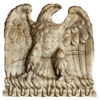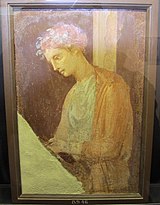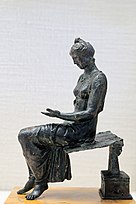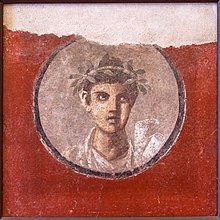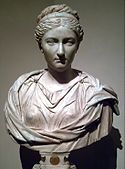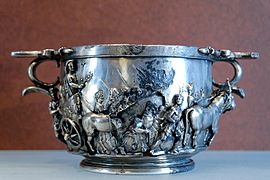Roman Empire
Roman Empire Imperium Romanum(Latin) | |||||||||||
|---|---|---|---|---|---|---|---|---|---|---|---|
| 27 BC–AD 395(unified)[1] AD 395–476/480(Western) AD 395–1453(Eastern) | |||||||||||
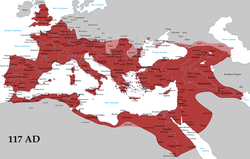 Roman Empire in AD 117 at its greatest territorial extent, at the time ofTrajan's death | |||||||||||
 Roman territorial evolution from the rise of the city-state of Rome to the fall of the Western Roman Empire | |||||||||||
| Capital |
| ||||||||||
| Common languages | |||||||||||
| Religion |
| ||||||||||
| Demonym(s) | Roman | ||||||||||
| Government | Autocracy | ||||||||||
| (List) | |||||||||||
| Historical era | Classical eratoLate Middle Ages (Timeline) | ||||||||||
| Area | |||||||||||
| 25 BC[15] | 2,750,000 km2(1,060,000 sq mi) | ||||||||||
| AD 117[15][16] | 5,000,000 km2(1,900,000 sq mi) | ||||||||||
| AD 390[15] | 3,400,000 km2(1,300,000 sq mi) | ||||||||||
| Population | |||||||||||
• 25 BC[17] | 56,800,000 | ||||||||||
| Currency | Sestertius,[d]aureus,solidus,nomisma | ||||||||||
| |||||||||||
TheRoman Empirewas the state ruled by theRomansfollowingOctavian's assumption of sole rule under thePrincipatein 27 BC, the post-Republicanstate ofancient Rome.It included territories inEurope,North Africa,andWestern Asiaand was ruled byemperors.Thefall of the Western Roman Empirein 476 AD conventionally marks the end ofclassical antiquityand the beginning of theMiddle Ages.
By 100 BC, Rome had expanded its rule to most of theMediterraneanand beyond. However, it was severely destabilized bycivil wars and political conflicts,which culminated in thevictory of OctavianoverMark AntonyandCleopatraat theBattle of Actiumin 31 BC, and the subsequent conquest of thePtolemaic Kingdomin Egypt. In 27 BC, theRoman SenategrantedOctavianoverarching power (imperium) and the new title ofAugustus,marking hisaccession as the first Roman emperorof amonarchywithRomeas its sole capital. The vast Roman territories were organized intosenatorialprovinces, governed by proconsuls who were appointed by lot annually, andimperialprovinces, which belonged to the emperor but were governed bylegates.[18]
Thefirst two centuries of the Empiresaw a period of unprecedented stability and prosperity known as thePax Romana(lit. 'Roman Peace'). Rome reached itsgreatest territorial extentunderTrajan(r. 98–117 AD); a period of increasing trouble and decline began underCommodus(180–192). In the 3rd century, the Empire underwent acrisisthat threatened its existence, as theGallicandPalmyreneEmpires broke away from the Roman state, and a series ofshort-lived emperorsled the Empire. It was reunified underAurelian(r. 270–275).Diocletianset up two different imperial courts in theGreek East and Latin Westin 286;Christians rose to powerin the 4th century after theEdict of Milan.The imperial seat moved from Rome toByzantiumin 330, renamedConstantinopleafterConstantine the Great.TheMigration Period,involvinglarge invasions by Germanic peoplesand by theHunsofAttila,led to the decline of theWestern Roman Empire.With thefall of Ravennato theGermanic Heruliansand thedeposition of Romulus Augustusin 476 AD byOdoacer,theWestern Roman Empirefinally collapsed. TheEastern Roman Empiresurvived for another millennium withConstantinopleas its sole capital, untilthe city's fallin 1453.[e]
Due to the Empire's extent and endurance, its institutions and culture hada lasting influenceon the development oflanguage,religion,art,architecture,literature,philosophy,law,andforms of governmentacross its territories.Latinevolved into theRomance languageswhileMedieval Greekbecame the language of the East. TheEmpire's adoptionofChristianityresulted in the formation of medievalChristendom.Roman andGreek arthad a profound impact on theItalian Renaissance.Rome's architectural tradition served as the basis forRomanesque,RenaissanceandNeoclassical architecture,influencingIslamic architecture.The rediscovery ofclassical scienceandtechnology(which formed the basis forIslamic science) in medieval Europe contributed to theScientific RenaissanceandScientific Revolution.Many modern legal systems, such as theNapoleonic Code,descend from Roman law. Rome's republican institutions haveinfluencedtheItalian city-state republicsof the medieval period, the earlyUnited States,and modern democraticrepublics.
History
Transition from Republic to Empire
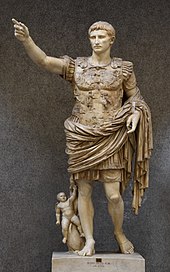
Rome had begun expanding shortly after the founding of theRoman Republicin the 6th century BC, though not outside theItalian Peninsulauntil the 3rd century BC. Thus, it was an "empire" (a great power) long before it had an emperor.[20]The Republic was not a nation-state in the modern sense, but a network of self-ruled towns (with varying degrees of independence from theSenate) and provinces administered by military commanders. It was governed by annually electedmagistrates(Roman consulsabove all) in conjunction with the Senate.[21]The 1st century BC was a time of political and military upheaval, which ultimately led to rule by emperors.[22][23][24]The consuls' military power rested in the Roman legal concept ofimperium,meaning "command" (though typically in a military sense).[25]Occasionally, successful consuls were given the honorary titleimperator(commander); this is the origin of the wordemperor,since this title was always bestowed to the early emperors.[26]
Rome suffered a long series of internal conflicts, conspiracies, andcivil warsfrom the late second century BC (seeCrisis of the Roman Republic) while greatly extending its power beyond Italy. In 44 BCJulius Caesarwas brieflydictatorbefore beingassassinated.The faction of his assassins was driven from Rome and defeated at theBattle of Philippiin 42 BC byMark Antonyand Caesar's adopted sonOctavian.Antony and Octavian's division of the Roman world did not last and Octavian's forces defeated those of Mark Antony andCleopatraat theBattle of Actiumin 31 BC. In 27 BC theSenatemade Octavianprinceps( "first citizen" ) withproconsularimperium,thus beginning thePrincipate(the first epoch of Roman imperial history, usually dated from 27 BC to 284 AD), and gave him the titleAugustus( "the venerated" ). Although the republic stood in name, Augustus had all meaningful authority.[27]Since his rule began an unprecedented period of peace and prosperity, he was so loved that he came to hold the power of a monarchde factoif notde jure.During the years of his rule, a new constitutional order emerged (in part organically and in part by design), so that, upon his death, this new constitutional order operated as before whenTiberiuswas accepted as the new emperor.[citation needed]
AsRoman provinceswere being established throughout the Mediterranean, Italy maintained a special status which made itdominaprovinciarum( "ruler of the provinces" ),[28][29][30]and – especially in relation to thefirst centuries of imperial stability–rectrix mundi( "governor of the world" )[31][32]andomnium terrarum parens( "parent of all lands" ).[33][34]
Pax Romana
The 200 years that began with Augustus's rule is traditionally regarded as thePax Romana( "Roman Peace" ). The cohesion of the empire was furthered by a degree of social stability and economic prosperity that Rome had never before experienced. Uprisings in the provinces were infrequent and put down "mercilessly and swiftly".[35]The success of Augustus in establishing principles of dynastic succession was limited by his outliving a number of talented potential heirs. TheJulio-Claudian dynastylasted for four more emperors—Tiberius,Caligula,Claudius,andNero—before it yielded in 69 AD to the strife-tornYear of the Four Emperors,from whichVespasianemerged as victor. Vespasian became the founder of the briefFlavian dynasty,followed by theNerva–Antonine dynastywhich produced the "Five Good Emperors":Nerva,Trajan,Hadrian,Antoninus Pius,andMarcus Aurelius.[citation needed]
Transition from classical to late antiquity

In the view of contemporary Greek historianCassius Dio,the accession ofCommodusin 180 marked the descent "from a kingdom of gold to one of rust and iron",[36]a comment which has led some historians, notablyEdward Gibbon,to take Commodus' reign as the beginning of theEmpire's decline.[37][38]
In 212, during the reign ofCaracalla,Roman citizenshipwas granted to all freeborn inhabitants of the empire. TheSeveran dynastywas tumultuous; an emperor's reign was ended routinely by his murder or execution and, following its collapse, the Empire was engulfed by theCrisis of the Third Century,a period ofinvasions,civil strife,economic disorder,andplague.[39]In defininghistorical epochs,this crisis sometimes marks the transition fromClassicaltoLate Antiquity.Aurelian(r. 270–275) stabilised the empire militarily andDiocletianreorganised and restored much of it in 285.[40]Diocletian's reign brought the empire's most concerted effort against the perceived threat ofChristianity,the "Great Persecution".[citation needed]
Diocletian divided the empire into four regions, each ruled by a separatetetrarch.[41]Confident that he fixed the disorder plaguing Rome, he abdicated along with his co-emperor, but the Tetrarchycollapsed shortly after.Order was eventually restored byConstantine the Great,who became the first emperor toconvert to Christianity,and who establishedConstantinopleas the new capital of the Eastern Empire. During the decades of theConstantinianandValentiniandynasties, the empire was divided along an east–west axis, with dual power centres in Constantinople and Rome.Julian,who under the influence of his adviserMardoniusattempted to restoreClassical RomanandHellenistic religion,only briefly interrupted the succession of Christian emperors.Theodosius I,the last emperor to rule over both East and West, died in 395 after making Christianity thestate religion.[42]


Fall in the West and survival in the East
TheWestern Roman Empirebegan todisintegratein the early 5th century. The Romans were successful in fighting off all invaders, most famouslyAttila,[43]but the empire hadassimilated so many Germanic peoplesof dubious loyalty to Rome that the empire started to dismember itself.[44]Most chronologiesplace the end of the Western Roman Empire in 476, whenRomulus Augustuluswasforced to abdicateto theGermanicwarlordOdoacer.[45][46][47]
Odoacer ended the Western Empire by declaringZenosole emperor and placing himself as Zeno's nominal subordinate. In reality, Italy was ruled by Odoacer alone.[45][46][48]The Eastern Roman Empire, called theByzantine Empireby later historians, continued until the reign ofConstantine XI Palaiologos.The last Roman emperor died in battle in 1453 againstMehmed IIand hisOttomanforces during thesiege of Constantinople.Mehmed II adopted the title ofcaesarin an attempt to claim a connection to the Empire.[49]
Geography and demography
The Roman Empire wasone of the largestin history, with contiguous territories throughout Europe, North Africa, and the Middle East.[50]The Latin phraseimperium sine fine( "empire without end"[51]) expressed the ideology that neither time nor space limited the Empire. InVirgil'sAeneid,limitless empire is said to be granted to the Romans byJupiter.[52]This claim of universal dominion was renewed when the Empire came under Christian rule in the 4th century.[f]In addition to annexing large regions, the Romans directly altered their geography, for examplecutting down entire forests.[54]
Roman expansionwas mostly accomplished under theRepublic,though parts of northern Europe were conquered in the 1st century, when Roman control in Europe, Africa, and Asia was strengthened. UnderAugustus,a "global map of the known world" was displayed for the first time in public at Rome, coinciding with the creation of the most comprehensivepolitical geographythat survives from antiquity, theGeographyofStrabo.[55]When Augustus died, the account of his achievements (Res Gestae) prominently featured the geographical cataloguing of the Empire.[56]Geography alongside meticulous written records were central concerns ofRoman Imperial administration.[57]

The Empire reached its largest expanse underTrajan(r. 98–117),[58]encompassing 5 million km2.[15][16]The traditional population estimate of55–60 millioninhabitants[59]accounted for between one-sixth and one-fourth of the world's total population[60]and made it the most populous unified political entity in the West until the mid-19th century.[61]Recentdemographic studieshave argued for a population peak from70 millionto more than100 million.[62]Each of the three largest cities in the Empire – Rome,Alexandria,andAntioch– was almost twice the size of any European city at the beginning of the 17th century.[63]
As the historianChristopher Kellydescribed it:
Then the empire stretched fromHadrian's Wallin drizzle-soakednorthern Englandto the sun-baked banks of theEuphratesin Syria; from the greatRhine–Danuberiver system, which snaked across the fertile, flat lands of Europe from theLow Countriesto theBlack Sea,to the rich plains of the North African coast and the luxuriant gash of theNile Valleyin Egypt. The empire completely circled theMediterranean... referred to by its conquerors asmare nostrum—'our sea'.[59]

Trajan's successorHadrianadopted a policy of maintaining rather than expanding the empire. Borders (fines) were marked, and the frontiers (limites) patrolled.[58]The most heavily fortified borders were the most unstable.[23]Hadrian's Wall,which separated the Roman world from what was perceived as an ever-presentbarbarianthreat, is the primary surviving monument of this effort.[65]
Languages
Latin and Greek were the main languages of the Empire,[g]but the Empire was deliberately multilingual.[70]Andrew Wallace-Hadrillsays "The main desire of the Roman government was to make itself understood".[71]At the start of the Empire, knowledge of Greek was useful to pass as educated nobility and knowledge of Latin was useful for a career in the military, government, or law.[72]Bilingual inscriptions indicate the everyday interpenetration of the two languages.[73]
Latin and Greek's mutual linguistic and cultural influence is a complex topic.[74]Latin words incorporated into Greek were very common by the early imperial era, especially for military, administration, and trade and commerce matters.[75]Greek grammar, literature, poetry and philosophy shaped Latin language and culture.[76][77]
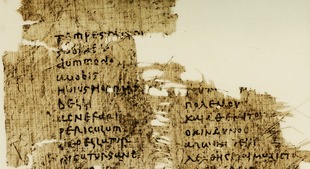
There was never a legal requirement for Latin in the Empire, but it represented a certain status.[79]High standards of Latin,Latinitas,started with the advent of Latin literature.[80]Due to the flexible language policy of the Empire, a natural competition of language emerged that spurredLatinitas,to defend Latin against the stronger cultural influence of Greek.[81]Over time Latin usage was used to project power and a higher social class.[82][83]Most of the emperors were bilingual but had a preference for Latin in the public sphere for political reasons, a "rule" that first started during thePunic Wars.[84]Different emperors up until Justinian would attempt to require the use of Latin in various sections of the administration but there is no evidence that a linguistic imperialism existed during the early Empire.[85]
After all freeborn inhabitants were universallyenfranchisedin212,many Roman citizens would have lacked a knowledge of Latin.[86]The wide use ofKoine Greekwas what enabled the spread of Christianity and reflects its role as thelingua francaof the Mediterranean during the time of the Empire.[87]Following Diocletian's reforms in the 3rd century CE, there was a decline in the knowledge of Greek in the west.[88]Spoken Latin later fragmented into the incipientromance languagesin the 7th century CE following the collapse of the Empire's west.[89]
The dominance of Latin and Greek among the literate elite obscure the continuity of other spoken languages within the Empire.[90]Latin, referred to in its spoken form asVulgar Latin,gradually replacedCelticandItalic languages.[91][92]References to interpreters indicate the continuing use of local languages, particularly in Egypt withCoptic,and in military settings along the Rhine and Danube. Romanjuristsalso show a concern for local languages such asPunic,Gaulish,andAramaicin assuring the correct understanding of laws and oaths.[93]InAfrica,Libyco-Berber and Punic were used in inscriptions into the 2nd century.[90]InSyria,Palmyrenesoldiers used theirdialect of Aramaicfor inscriptions, an exception to the rule that Latin was the language of the military.[94]The last reference to Gaulish was between 560 and 575.[95][96]The emergentGallo-Romance languageswould then be shaped by Gaulish.[97]Proto-BasqueorAquitanianevolved with Latin loan words to modernBasque.[98]TheThracian language,as were several now-extinct languages in Anatolia, are attested in Imperial-era inscriptions.[87][90]
Society
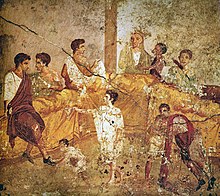
The Empire was remarkably multicultural, with "astonishing cohesive capacity" to create shared identity while encompassing diverse peoples.[100]Public monuments and communal spaces open to all—such asforums,amphitheatres,racetracksandbaths—helped foster a sense of "Romanness".[101]
Roman society had multiple, overlappingsocial hierarchies.[102]The civil war preceding Augustus caused upheaval,[103]but did not effect an immediateredistribution of wealthand social power. From the perspective of the lower classes, a peak was merely added to the social pyramid.[104]Personal relationships—patronage,friendship (amicitia),family,marriage—continued to influence politics.[105]By the time ofNero,however, it was not unusual to find a former slave who was richer than a freeborn citizen, or anequestrianwho exercised greater power than a senator.[106]
The blurring of the Republic's more rigid hierarchies led to increasedsocial mobility,[107]both upward and downward, to a greater extent than all other well-documented ancient societies.[108]Women, freedmen, and slaves had opportunities to profit and exercise influence in ways previously less available to them.[109]Social life, particularly for those whose personal resources were limited, was further fostered by a proliferation ofvoluntary associationsandconfraternities(collegiaandsodalitates): professional and trade guilds, veterans' groups, religious sodalities, drinking and dining clubs,[110]performing troupes,[111]andburial societies.[112]
Legal status
According to thejurist Gaius,the essential distinction in the Roman "law of persons"was that all humans were either free (liberi) or slaves (servi).[113]The legal status of free persons was further defined by their citizenship. Most citizens held limited rights (such as theius Latinum,"Latin right" ), but were entitled to legal protections and privileges not enjoyed by non-citizens. Free people not considered citizens, but living within the Roman world, wereperegrini,non-Romans.[114]In 212, theConstitutio Antoninianaextended citizenship to all freeborn inhabitants of the empire. This legal egalitarianism required a far-reaching revision of existing laws that distinguished between citizens and non-citizens.[115]
Women in Roman law
Right:Bronze statuette (1st century AD) of a young woman reading, based on aHellenisticoriginal
Freeborn Roman women were considered citizens, but did not vote, hold political office, or serve in the military. A mother's citizen status determined that of her children, as indicated by the phraseex duobus civibus Romanis natos( "children born of two Roman citizens" ).[h]A Roman woman kept her ownfamily name(nomen) for life. Children most often took the father's name, with some exceptions.[118]Women could own property, enter contracts, and engage in business.[119]Inscriptions throughout the Empire honour women as benefactors in funding public works, an indication they could hold considerable fortunes.[120]
The archaicmanusmarriagein which the woman was subject to her husband's authority was largely abandoned by the Imperial era, and a married woman retained ownership of any property she brought into the marriage. Technically she remained under her father's legal authority, even though she moved into her husband's home, but when her father died she became legally emancipated.[121]This arrangement was a factor in the degree of independence Roman women enjoyed compared to many other cultures up to the modern period:[122]although she had to answer to her father in legal matters, she was free of his direct scrutiny in daily life,[123]and her husband had no legal power over her.[124]Although it was a point of pride to be a "one-man woman" (univira) who had married only once, there was little stigma attached todivorce,nor to speedy remarriage after being widowed or divorced.[125]Girls had equal inheritance rights with boys if their father died without leaving a will.[126]A mother's right to own and dispose of property, including setting the terms of her will, gave her enormous influence over her sons into adulthood.[127]

As part of the Augustan programme to restore traditional morality and social order,moral legislationattempted to regulate conduct as a means of promoting "family values".Adulterywas criminalized,[128]and defined broadly as an illicit sex act (stuprum) between a male citizen and a married woman, or between a married woman and any man other than her husband. That is, adouble standardwas in place: a married woman could have sex only with her husband, but a married man did not commit adultery if he had sex with a prostitute or person of marginalized status.[129]Childbearing was encouraged: a woman who had given birth to three children was granted symbolic honours and greater legal freedom (theius trium liberorum).[130]
Slaves and the law
At the time of Augustus, as many as 35% of the people inRoman Italywere slaves,[131]making Rome one of five historical "slave societies" in which slaves constituted at least a fifth of the population and played a major role in the economy.[i][131]Slavery was a complex institution that supported traditional Roman social structures as well as contributing economic utility.[132]In urban settings, slaves might be professionals such as teachers, physicians, chefs, and accountants; the majority of slaves provided trained or unskilled labour.Agricultureand industry, such as milling and mining, relied on the exploitation of slaves. Outside Italy, slaves were on average an estimated 10 to 20% of the population, sparse inRoman Egyptbut more concentrated in some Greek areas. Expanding Roman ownership of arable land and industries affected preexisting practices of slavery in the provinces.[133]Although slavery has often been regarded as waning in the 3rd and 4th centuries, it remained an integral part of Roman society until gradually ceasing in the 6th and 7th centuries with the disintegration of the complex Imperial economy.[134]
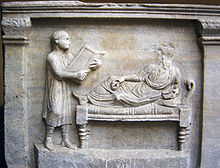
Laws pertaining to slavery were "extremely intricate".[135]Slaves were considered property and had nolegal personhood.They could be subjected to forms of corporal punishment not normally exercised on citizens,sexual exploitation,torture, andsummary execution.A slave could not as a matter of law be raped; a slave's rapist had to be prosecuted by the owner for property damage under theAquilian Law.[136]Slaves had no right to the form of legal marriage calledconubium,but their unions were sometimes recognized.[137]Technically, a slave could not own property,[138]but a slave who conducted business might be given access to an individual fund (peculium) that he could use, depending on the degree of trust and co-operation between owner and slave.[139]Within a household or workplace, a hierarchy of slaves might exist, with one slave acting as the master of others.[140]Talented slaves might accumulate a large enoughpeculiumto justify their freedom, or bemanumittedfor services rendered. Manumission had become frequent enough that in 2 BC a law (Lex Fufia Caninia) limited the number of slaves an owner was allowed to free in his will.[141]
Following theServile Warsof the Republic, legislation under Augustus and his successors shows a driving concern for controlling the threat of rebellions through limiting the size of work groups, and for hunting down fugitive slaves.[142]Over time slaves gained increased legal protection, including the right to file complaints against their masters. A bill of sale might contain a clause stipulating that the slave could not be employed for prostitution, asprostitutes in ancient Romewere often slaves.[143]The burgeoning trade ineunuchsin the late 1st century prompted legislation that prohibited thecastrationof a slave against his will "for lust or gain".[144]
Roman slavery was not based onrace.[145]Generally, slaves in Italy were indigenous Italians,[146]with a minority of foreigners (including both slaves and freedmen) estimated at 5% of the total in the capital at its peak, where their number was largest. Foreign slaves had higher mortality and lower birth rates than natives, and were sometimes even subjected to mass expulsions.[147]The average recorded age at death for the slaves of the city of Rome was seventeen and a half years (17.2 for males; 17.9 for females).[148]
During the period of republican expansionism when slavery had become pervasive, war captives were a main source of slaves. The range of ethnicities among slaves to some extent reflected that of the armies Rome defeated in war, and theconquest of Greecebrought a number of highly skilled and educated slaves. Slaves were also traded in markets and sometimes sold bypirates.Infant abandonmentand self-enslavement among the poor were other sources.[149]Vernae,by contrast, were "homegrown" slaves born to female slaves within the household, estate or farm. Although they had no special legal status, an owner who mistreated or failed to care for hisvernaefaced social disapproval, as they were considered part of the family household and in some cases might actually be the children of free males in the family.[150]
Freedmen

Rome differed fromGreek city-statesin allowing freed slaves to become citizens; any future children of a freedman were born free, with full rights of citizenship. After manumission, a slave who had belonged to a Roman citizen enjoyed active political freedom (libertas), including the right to vote.[151]His former master became his patron (patronus): the two continued to have customary and legal obligations to each other.[152][153]A freedman was not entitled to hold public office or the highest state priesthoods, but could play apriestly role.He could not marry a woman from a senatorial family, nor achieve legitimate senatorial rank himself, but during the early Empire, freedmen held key positions in the government bureaucracy, so much so thatHadrianlimited their participation by law.[153]The rise of successful freedmen—through political influence or wealth—is a characteristic of early Imperial society. The prosperity of a high-achieving group of freedmen is attested byinscriptions throughout the Empire,and by their ownership of some of the most lavish houses atPompeii.[citation needed]
Census rank
The Latin wordordo(pluralordines) is translated variously and inexactly into English as "class, order, rank". One purpose of theRoman censuswas to determine theordoto which an individual belonged. The two highestordinesin Rome were the senatorial and equestrian.[citation needed]Outside Rome, thedecurions,also known ascuriales,were the top governingordoof an individual city.[citation needed]
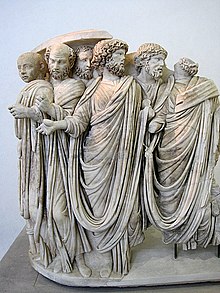
"Senator" was not itself an elected office in ancient Rome; an individual gained admission to the Senate after he had been elected to and served at least one term as anexecutive magistrate.A senator also had to meet a minimum property requirement of 1 millionsestertii.[154]Not all men who qualified for theordo senatoriuschose to take a Senate seat, which requiredlegal domicileat Rome. Emperors often filled vacancies in the 600-member body by appointment.[155]A senator's son belonged to theordo senatorius,but he had to qualify on his own merits for admission to the Senate. A senator could be removed for violating moral standards.[156]
In the time of Nero, senators were still primarily fromItaly,with some from the Iberian peninsula and southern France; men from the Greek-speaking provinces of the East began to be added under Vespasian.[157]The first senator from the easternmost province,Cappadocia,was admitted under Marcus Aurelius.[j]By theSeveran dynasty(193–235), Italians made up less than half the Senate.[159]During the 3rd century, domicile at Rome became impractical, and inscriptions attest to senators who were active in politics and munificence in their homeland (patria).[156]
Senators were the traditional governing class who rose through thecursus honorum,the political career track, but equestrians often possessed greater wealth and political power. Membership in the equestrian order was based on property; in Rome's early days,equitesor knights had been distinguished by their ability to serve as mounted warriors, but cavalry service was a separate function in the Empire.[k]A census valuation of 400,000 sesterces and three generations of free birth qualified a man as an equestrian.[161]The census of 28 BC uncovered large numbers of men who qualified, and in 14 AD, a thousand equestrians were registered atCádizandPaduaalone.[l][163]Equestrians rose through a military career track (tres militiae) to become highly placedprefectsandprocuratorswithin the Imperial administration.[164]
The rise of provincial men to the senatorial and equestrian orders is an aspect of social mobility in the early Empire. Roman aristocracy was based on competition, and unlike laterEuropean nobility,a Roman family could not maintain its position merely through hereditary succession or having title to lands.[165]Admission to the higherordinesbrought distinction and privileges, but also responsibilities. In antiquity, a city depended on its leading citizens to fund public works, events, and services (munera). Maintaining one's rank required massive personal expenditures.[166]Decurions were so vital for the functioning of cities that in the later Empire, as the ranks of the town councils became depleted, those who had risen to the Senate were encouraged to return to their hometowns, in an effort to sustain civic life.[167]
In the later Empire, thedignitas( "worth, esteem" ) that attended on senatorial or equestrian rank was refined further with titles such asvir illustris( "illustrious man" ).[168]The appellationclarissimus(Greeklamprotatos) was used to designate thedignitasof certain senators and their immediate family, including women.[169]"Grades" of equestrian status proliferated.[170]
Unequal justice
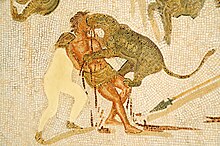
As the republican principle of citizens' equality under the law faded, the symbolic and social privileges of the upper classes led to an informal division of Roman society into those who had acquired greater honours (honestiores) and humbler folk (humiliores). In general,honestioreswere the members of the three higher "orders", along with certain military officers.[171]The granting of universal citizenship in 212 seems to have increased the competitive urge among the upper classes to have their superiority affirmed, particularly within the justice system.[172]Sentencing depended on the judgment of the presiding official as to the relative "worth" (dignitas) of the defendant: anhonestiorcould pay a fine for a crime for which anhumiliormight receive ascourging.[173]
Execution, which was an infrequent legal penalty for free men under the Republic,[174]could be quick and relatively painless forhonestiores,whilehumilioresmight suffer the kinds of torturous death previously reserved for slaves, such ascrucifixionandcondemnation to the beasts.[175]In the early Empire, those who converted to Christianity could lose their standing ashonestiores,especially if they declined to fulfil religious responsibilities, and thus became subject to punishments that created the conditions ofmartyrdom.[176]
Government and military

The three major elements of the Imperial state were the central government, the military, and the provincial government.[177]The military established control of a territory through war, but after a city or people was brought under treaty, the mission turned to policing: protecting Roman citizens, agricultural fields, and religious sites.[178]The Romans lacked sufficient manpower or resources to rule through force alone.Cooperation with local eliteswas necessary to maintain order, collect information, and extract revenue. The Romans often exploited internal political divisions.[179]
Communities with demonstrated loyalty to Rome retained their own laws, could collect their own taxes locally, and in exceptional cases were exempt from Roman taxation. Legal privileges and relative independence incentivized compliance.[180]Roman government was thuslimited,but efficient in its use of available resources.[181]
Central government
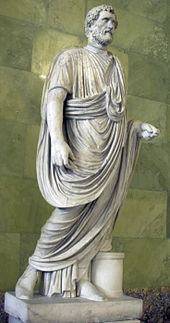
TheImperial cult of ancient Romeidentifiedemperorsand some members of their families withdivinely sanctionedauthority (auctoritas). The rite ofapotheosis(also calledconsecratio) signified the deceased emperor's deification.[182]The dominance of the emperor was based on the consolidation of powers from several republican offices.[183]The emperor made himself the central religious authority aspontifex maximus,and centralized the right to declare war, ratify treaties, and negotiate with foreign leaders.[184]While these functions were clearly defined during thePrincipate,the emperor's powers over time became less constitutional and more monarchical, culminating in theDominate.[185]
The emperor was the ultimate authority in policy- and decision-making, but in the early Principate, he was expected to be accessible and deal personally with official business and petitions. A bureaucracy formed around him only gradually.[186]The Julio-Claudian emperors relied on an informal body of advisors that included not only senators and equestrians, but trusted slaves and freedmen.[187]After Nero, the influence of the latter was regarded with suspicion, and the emperor's council (consilium) became subject to official appointment for greatertransparency.[188]Though the Senate took a lead in policy discussions until the end of theAntonine dynasty,equestrians played an increasingly important role in theconsilium.[189]The women of the emperor's family often intervened directly in his decisions.[190]
Access to the emperor might be gained at the daily reception (salutatio), a development of the traditional homage a client paid to his patron; public banquets hosted at the palace; and religious ceremonies. The common people who lacked this access could manifest their approval or displeasure as a group atgames.[191]By the 4th century, the Christian emperors became remote figureheads who issued general rulings, no longer responding to individual petitions.[192]Although the Senate could do little short of assassination and open rebellion to contravene the will of the emperor, it retained its symbolic political centrality.[193]The Senate legitimated the emperor's rule, and the emperor employed senators as legates (legati): generals, diplomats, and administrators.[194]
The practical source of an emperor's power and authority was the military. Thelegionarieswere paid by the Imperial treasury, and swore an annualoath of loyaltyto the emperor.[195]Most emperors chose a successor, usually a close family member oradoptedheir. The new emperor had to seek a swift acknowledgement of his status and authority to stabilize the political landscape. No emperor could hope to survive without the allegiance of thePraetorian Guardand the legions. To secure their loyalty, several emperors paid thedonativum,a monetary reward. In theory, the Senate was entitled to choose the new emperor, but did so mindful of acclamation by the army or Praetorians.[196]
Military
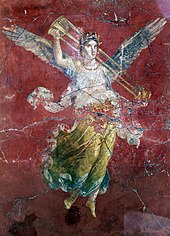

After thePunic Wars,the Roman army comprised professional soldiers who volunteered for 20 years of active duty and five as reserves. The transition to a professional military began during the late Republic and was one of the many profound shifts away from republicanism, under which an army ofconscript citizensdefended the homeland against a specific threat. The Romans expanded their war machine by "organizing the communities that they conquered in Italy into a system that generated huge reservoirs of manpower for their army".[197]By Imperial times, military service was a full-time career.[198]The pervasiveness of military garrisons throughout the Empire was a major influence in the process ofRomanization.[199]
The primary mission of the military of the early empire was to preserve thePax Romana.[200]The three major divisions of the military were:
- the garrison at Rome, comprising thePraetorian Guard,thecohortes urbanaeand thevigiles,who functioned as police and firefighters;
- the provincial army, comprising theRoman legionsand the auxiliaries provided by the provinces (auxilia);
- thenavy.

Through his military reforms, which included consolidating or disbanding units of questionable loyalty, Augustus regularized the legion. A legion was organized into tencohorts,each of which comprised sixcenturies,with a century further made up of ten squads (contubernia); the exact size of the Imperial legion, which was likely determined bylogistics,has been estimated to range from 4,800 to 5,280.[201]After Germanic tribes wiped out three legions in theBattle of the Teutoburg Forestin 9 AD, the number of legions was increased from 25 to around 30.[202]The army had about 300,000 soldiers in the 1st century, and under 400,000 in the 2nd, "significantly smaller" than the collective armed forces of the conquered territories. No more than 2% of adult males living in the Empire served in the Imperial army.[203]Augustus also created thePraetorian Guard:nine cohorts, ostensibly to maintain the public peace, which were garrisoned in Italy. Better paid than the legionaries, the Praetorians served only sixteen years.[204]
Theauxiliawere recruited from among the non-citizens. Organized in smaller units of roughly cohort strength, they were paid less than the legionaries, and after 25 years of service were rewarded withRoman citizenship,also extended to their sons. According toTacitus[205]there were roughly as many auxiliaries as there were legionaries—thus, around 125,000 men, implying approximately 250 auxiliary regiments.[206]TheRoman cavalryof the earliest Empire were primarily from Celtic, Hispanic or Germanic areas. Several aspects of training and equipment derived from the Celts.[207]
TheRoman navynot only aided in the supply and transport of the legions but also in the protection of thefrontiersalong the riversRhineandDanube.Another duty was protecting maritime trade against pirates. It patrolled the Mediterranean, parts of theNorth Atlanticcoasts, and theBlack Sea.Nevertheless, the army was considered the senior and more prestigious branch.[208]
Provincial government
An annexed territory became aRoman provincein three steps: making a register of cities, taking a census, and surveying the land.[209]Further government recordkeeping included births and deaths, real estate transactions, taxes, and juridical proceedings.[210]In the 1st and 2nd centuries, the central government sent out around 160 officials annually to govern outside Italy.[21]Among these officials were theRoman governors:magistrates elected at Romewho in the name of theRoman peoplegovernedsenatorial provinces;or governors, usually of equestrian rank, who held theirimperiumon behalf of the emperor inimperial provinces,most notablyRoman Egypt.[211]A governor had to make himself accessible to the people he governed, but he could delegate various duties.[212]His staff, however, was minimal: his official attendants (apparitores), includinglictors,heralds, messengers,scribes,and bodyguards;legates,both civil and military, usually of equestrian rank; and friends who accompanied him unofficially.[212]
Other officials were appointed as supervisors of government finances.[21]Separating fiscal responsibility from justice and administration was a reform of the Imperial era, to avoid provincial governors andtax farmersexploiting local populations for personal gain.[213]Equestrianprocurators,whose authority was originally "extra-judicial and extra-constitutional", managed both state-owned property and the personal property of the emperor (res privata).[212]Because Roman government officials were few, a provincial who needed help with a legal dispute or criminal case might seek out any Roman perceived to have some official capacity.[214]
Law
Roman courts heldoriginal jurisdictionover cases involving Roman citizens throughout the empire, but there were too few judicial functionaries to impose Roman law uniformly in the provinces. Most parts of the Eastern Empire already had well-established law codes and juridical procedures.[103]Generally, it was Roman policy to respect themos regionis( "regional tradition" or "law of the land" ) and to regard local laws as a source of legal precedent and social stability.[103][215]The compatibility of Roman and local law was thought to reflect an underlyingius gentium,the "law of nations" orinternational lawregarded as common and customary.[216]If provincial law conflicted with Roman law or custom, Roman courts heardappeals,and the emperor held final decision-making authority.[103][215][m]
In the West, law had been administered on a highly localized or tribal basis, andprivate property rightsmay have been a novelty of the Roman era, particularly amongCelts.Roman law facilitated the acquisition of wealth by a pro-Roman elite.[103]The extension of universal citizenship to all free inhabitants of the Empire in 212 required the uniform application of Roman law, replacing local law codes that had applied to non-citizens. Diocletian's efforts to stabilize the Empire after theCrisis of the Third Centuryincluded two major compilations of law in four years, theCodex Gregorianusand theCodex Hermogenianus,to guide provincial administrators in setting consistent legal standards.[217]
The pervasiveness of Roman law throughout Western Europe enormously influenced the Western legal tradition, reflected by continued use ofLatin legal terminologyin modern law.[citation needed]
Taxation
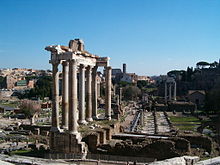
Taxation under the Empire amounted to about 5% of itsgross product.[218]The typical tax rate for individuals ranged from 2 to 5%.[219]The tax code was "bewildering" in its complicated system ofdirectandindirect taxes,some paid in cash and somein kind.Taxes might be specific to a province, or kinds of properties such asfisheries;they might be temporary.[220]Tax collection was justified by the need to maintain the military,[221]and taxpayers sometimes got a refund if the army captured a surplus of booty.[222]In-kind taxes were accepted from less-monetizedareas, particularly those who could supply grain or goods to army camps.[223]
The primary source of direct tax revenue was individuals, who paid apoll taxand a tax on their land, construed as a tax on its produce or productive capacity.[219]Tax obligations were determined by the census: each head of household provided a headcount of his household, as well as an accounting of his property.[224]A major source of indirect-tax revenue was theportoria,customs and tolls on trade, including among provinces.[219]Towards the end of his reign, Augustus instituted a 4% tax on the sale of slaves,[225]which Nero shifted from the purchaser to the dealers, who responded by raising their prices.[226]An owner who manumitted a slave paid a "freedom tax", calculated at 5% of value.[n]Aninheritance taxof 5% was assessed when Roman citizens above a certain net worth left property to anyone outside their immediate family. Revenues from the estate tax and from an auction tax went towards the veterans' pension fund (aerarium militare).[219]
Low taxes helped the Roman aristocracy increase their wealth, which equalled or exceeded the revenues of the central government. An emperor sometimes replenished his treasury by confiscating the estates of the "super-rich", but in the later period, theresistanceof the wealthy to paying taxes was one of the factors contributing to the collapse of the Empire.[60]
Economy

The Empire is best thought of as a network of regional economies, based on a form of "political capitalism" in which the state regulated commerce to assure its own revenues.[227]Economic growth, though not comparable to modern economies, was greater than that of most other societies prior toindustrialization.[228]Territorial conquests permitted a large-scale reorganization ofland usethat resulted in agricultural surplus and specialization, particularly in north Africa.[229]Some cities were known for particular industries. The scale of urban building indicates a significant construction industry.[229]Papyri preserve complex accounting methods that suggest elements ofeconomic rationalism,[229]and the Empire was highly monetized.[230]Although the means of communication and transport were limited in antiquity, transportation in the 1st and 2nd centuries expanded greatly, and trade routes connected regional economies.[231]Thesupply contracts for the armydrew on local suppliers near the base (castrum), throughout the province, and across provincial borders.[232] Economic historiansvary in their calculations of the gross domestic product during the Principate.[233]In the sample years of 14, 100, and 150 AD, estimates of per capita GDP range from 166 to 380HS.The GDP per capita ofItalyis estimated as 40[234]to 66%[235]higher than in the rest of the Empire, due to tax transfers from the provinces and the concentration of elite income.
Economic dynamism resulted in social mobility. Although aristocratic values permeated traditional elite society, wealth requirements forrankindicate a strong tendency towardsplutocracy.Prestige could be obtained through investing one's wealth in grand estates or townhouses, luxury items,public entertainments,funerary monuments, andreligious dedications.Guilds (collegia) and corporations (corpora) provided support for individuals to succeed through networking.[171]"There can be little doubt that the lower classes of... provincial towns of the Roman Empire enjoyed a highstandard of livingnot equaled again in Western Europe until the 19th century ".[236]Households in the top 1.5% ofincome distributioncaptured about 20% of income. The "vast majority" produced more than half of the total income, but lived nearsubsistence.[237]
Currency and banking


The early Empire was monetized to a near-universal extent, using money as a way to expresspricesanddebts.[239]Thesestertius(English "sesterces", symbolized asHS) was the basic unit of reckoning value into the 4th century,[240]though the silverdenarius,worth four sesterces, was also used beginning in theSeveran dynasty.[241]The smallest coin commonly circulated was the bronzeas,one-tenthdenarius.[242]Bullionandingotsseem not to have counted aspecunia( "money" ) and were used only on the frontiers. Romans in the first and second centuries counted coins, rather than weighing them—an indication that the coin was valued on its face. This tendency towardsfiat moneyled to thedebasementof Roman coinage in the later Empire.[243]The standardization of money throughout the Empire promoted trade and market integration.[239]The high amount of metal coinage in circulation increased themoney supplyfor trading or saving.[244] Rome had nocentral bank,and regulation of the banking system was minimal. Banks of classical antiquity typically keptless in reservesthan the full total of customers' deposits. A typical bank had fairly limitedcapital,and often only one principal.Senecaassumes that anyone involved inRoman commerceneeds access tocredit.[243]A professionaldepositbanker received and held deposits for a fixed or indefinite term, and lent money to third parties. The senatorial elite were involved heavily in private lending, both as creditors and borrowers.[245]The holder of a debt could use it as a means of payment by transferring it to another party, without cash changing hands. Although it has sometimes been thought that ancient Rome lackeddocumentary transactions,the system of banks throughout the Empire permitted the exchange of large sums without physically transferring coins, in part because of the risks of moving large amounts of cash. Only one serious credit shortage is known to have occurred in the early Empire, in 33 AD;[246]generally, available capital exceeded the amount needed by borrowers.[243]The central government itself did not borrow money, and withoutpublic debthad to funddeficitsfrom cash reserves.[247]
Emperors of theAntonineandSeverandynasties debased the currency, particularly thedenarius,under the pressures of meeting military payrolls.[240]Sudden inflation underCommodusdamaged the credit market.[243]In the mid-200s, the supply ofspeciecontracted sharply.[240]Conditions during theCrisis of the Third Century—such as reductions in long-distance trade, disruption of mining operations, and the physical transfer of gold coinage outside the empire by invading enemies—greatly diminished the money supply and the banking sector.[240][243]Although Roman coinage had long been fiat money orfiduciary currency,general economic anxieties came to a head underAurelian,and bankers lost confidence in coins. DespiteDiocletian's introduction of the goldsolidusand monetary reforms, the credit market of the Empire never recovered its former robustness.[243]
Mining and metallurgy
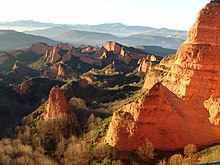
The main mining regions of the Empire were the Iberian Peninsula (silver, copper, lead, iron and gold);[248]Gaul (gold, silver, iron);[249]Britain (mainly iron, lead, tin),[250]theDanubian provinces(gold, iron);[251]MacedoniaandThrace(gold, silver); and Asia Minor (gold, silver, iron, tin). Intensive large-scale mining—of alluvial deposits, and by means ofopen-cast miningandunderground mining—took place from the reign of Augustus up to the early 3rd century, when the instability of the Empire disrupted production.[citation needed]
Hydraulic miningallowedbaseandprecious metalsto be extracted on a proto-industrial scale.[252]The total annual iron output is estimated at 82,500tonnes.[253]Copper and lead production levels were unmatched until theIndustrial Revolution.[254][255][256][257]At its peak around the mid-2nd century, the Roman silver stock is estimated at 10,000 t, five to ten times larger than the combined silver mass ofmedieval Europeand theCaliphatearound 800 AD.[256][258]As an indication of the scale of Roman metal production, lead pollution in theGreenland ice sheetquadrupled over prehistoric levels during the Imperial era and dropped thereafter.[259]
Transportation and communication

The Empire completely encircled the Mediterranean, which they called "our sea" (Mare Nostrum).[260]Roman sailing vessels navigated the Mediterranean as well as major rivers.[63]Transport by water was preferred where possible, as moving commodities by land was more difficult.[261]Vehicles, wheels, and ships indicate the existence of a great number of skilled woodworkers.[262]
Land transport utilized the advanced system ofRoman roads,called "viae".These roads were primarily built for military purposes,[263]but also served commercial ends. The in-kind taxes paid by communities included the provision of personnel, animals, or vehicles for thecursus publicus,the state mail and transport service established by Augustus.[223]Relay stations were located along the roads every seven to twelveRoman miles,and tended to grow into villages or trading posts.[264]Amansio(pluralmansiones) was a privately run service station franchised by the imperial bureaucracy for thecursus publicus.The distance betweenmansioneswas determined by how far a wagon could travel in a day.[264]Carts were usually pulled by mules, travelling about 4 mph.[265]
Trade and commodities
Roman provinces traded among themselves, but trade extended outside the frontiers to regions as far away asChinaandIndia.[266]Chinese trade was mostly conducted overland through middle men along theSilk Road;Indian trade also occurred by sea fromEgyptianports. The maincommoditywas grain.[267]Also traded were olive oil, foodstuffs,garum(fish sauce), slaves, ore and manufactured metal objects, fibres and textiles, timber,pottery,glassware,marble,papyrus,spices andmateria medica,ivory, pearls, and gemstones.[268]Though most provinces could produce wine,regional varietalswere desirable and wine was a central trade good.[269]
Labour and occupations

Inscriptions record 268 different occupations in Rome and 85 in Pompeii.[203]Professional associations or trade guilds (collegia) are attested for a wide range of occupations, some quite specialized.[171]
Work performed by slaves falls into five general categories: domestic, with epitaphs recording at least 55 different household jobs;imperial or public service;urban crafts and services; agriculture; and mining. Convicts provided much of the labour in the mines or quarries, where conditions were notoriously brutal.[270]In practice, there was little division of labour between slave and free,[103]and most workers were illiterate and without special skills.[271]The greatest number of common labourers were employed in agriculture: in Italian industrial farming (latifundia), these may have been mostly slaves, but elsewhere slave farm labour was probably less important.[103]
Textile and clothing production was a major source of employment. Both textiles and finished garments were traded and products were often named for peoples or towns, like afashion "label".[272]Better ready-to-wear was exported by local businessmen (negotiatoresormercatores).[273]Finished garments might be retailed by their sales agents, byvestiarii(clothing dealers), or peddled by itinerant merchants.[273]Thefullers(fullones) and dye workers (coloratores) had their own guilds.[274]Centonariiwere guild workers who specialized in textile production and the recycling of old clothes intopieced goods.[o]

Architecture and engineering
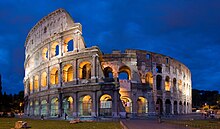
The chiefRoman contributions to architecturewere thearch,vaultanddome.Some Roman structures still stand today, due in part to sophisticated methods of making cements andconcrete.[277]Roman templesdevelopedEtruscanand Greek forms, with some distinctive elements.Roman roadsare considered the most advanced built until the early 19th century. The system of roadways facilitated military policing, communications, and trade, and were resistant to floods and other environmental hazards. Some remained usable for over a thousand years.[citation needed]
Roman bridgeswere among the first large and lasting bridges, built from stone (and in most cases concrete) with the arch as the basic structure. The largest Roman bridge wasTrajan's bridgeover the lower Danube, constructed byApollodorus of Damascus,which remained for over a millennium the longest bridge to have been built.[278]The Romans built manydams and reservoirsfor water collection, such as theSubiaco Dams,two of which fed theAnio Novus,one of the largest aqueducts of Rome.[279]

The Romans constructed numerousaqueducts.De aquaeductu,a treatise byFrontinus,who served aswater commissioner,reflects the administrative importance placed on the water supply. Masonry channels carried water along a precisegradient,usinggravityalone. It was then collected in tanks and fed through pipes to public fountains, baths,toilets,or industrial sites.[280]The main aqueducts in Rome were theAqua Claudiaand theAqua Marcia.[281]The complex system built to supply Constantinople had its most distant supply drawn from over 120 km away along a route of more than 336 km.[282]Roman aqueducts were built to remarkably finetolerance,and to a technological standard not equalled until modern times.[283]The Romans also used aqueducts in their extensive mining operations across the empire.[284]
Insulated glazing(or "double glazing" ) was used in the construction ofpublic baths.Elite housing in cooler climates might havehypocausts,a form of central heating. The Romans were the first culture to assemble all essential components of the much latersteam engine:the crank and connecting rod system,Hero'saeolipile(generating steam power), thecylinderandpiston(in metal force pumps), non-returnvalves(in water pumps), andgearing(in water mills and clocks).[285]
Daily life

City and country
The city was viewed as fostering civilization by being "properly designed, ordered, and adorned".[286]Augustus undertook a vast building programme in Rome, supported public displays of art that expressed imperial ideology, andreorganized the cityinto neighbourhoods(vici)administered at the local level with police and firefighting services.[287]A focus of Augustan monumental architecture was theCampus Martius,an open area outside the city centre: the Altar of Augustan Peace (Ara Pacis Augustae) was located there, as wasan obeliskimported from Egypt that formed the pointer (gnomon) of ahorologium.With its public gardens, the Campus was among the most attractive places in Rome to visit.[287]
City planning and urban lifestyles was influenced by the Greeks early on,[288]and in the Eastern Empire, Roman rule shaped the development of cities that already had a strong Hellenistic character. Cities such asAthens,Aphrodisias,EphesusandGerasatailored city planning and architecture to imperial ideals, while expressing their individual identity and regional preeminence.[289]In areas inhabited by Celtic-speaking peoples, Rome encouraged the development of urban centres with stone temples, forums, monumental fountains, and amphitheatres, often on or near the sites of preexisting walled settlements known asoppida.[290][291][p]Urbanization in Roman Africa expanded on Greek and Punic coastal cities.[264]

The network of cities (coloniae,municipia,civitatesor in Greek termspoleis) was a primary cohesive force during the Pax Romana.[192]Romans of the 1st and 2nd centuries were encouraged to "inculcate the habits of peacetime".[293]As the classicistClifford Andonoted:
Most of the culturalappurtenancespopularly associated with imperial culture—public cultand itsgamesandcivic banquets,competitions for artists, speakers, and athletes, as well as the funding of the great majority of public buildings and public display of art—were financed by private individuals, whose expenditures in this regard helped to justify their economic power and legal and provincial privileges.[294]
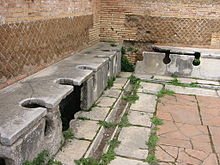
In the city of Rome, most people lived in multistory apartment buildings (insulae) that were often squalid firetraps. Public facilities—such as baths (thermae), toilets with running water (latrinae), basins or elaborate fountains (nymphea) delivering fresh water,[291]and large-scale entertainments such aschariot racesandgladiator combat—were aimed primarily at the common people.[295]Similar facilities were constructed in cities throughout the Empire, and some of the best-preserved Roman structures are in Spain, southern France, and northern Africa.[citation needed]
The public baths served hygienic, social and cultural functions.[296]Bathing was the focus of daily socializing.[297]Roman baths were distinguished by a series of rooms that offered communal bathing in three temperatures, with amenities that might include anexercise room,sauna,exfoliationspa,ball court,or outdoor swimming pool. Baths hadhypocaustheating: the floors were suspended over hot-air channels.[298]Public baths were part of urban culturethroughout the provinces,but in the late 4th century, individual tubs began to replace communal bathing. Christians were advised to go to the baths only for hygiene.[299]

Rich families from Rome usually had two or more houses: a townhouse (domus) and at least one luxury home (villa) outside the city. Thedomuswas a privately owned single-family house, and might be furnished with a private bath (balneum),[298]but it was not a place to retreat from public life.[300]Although some neighbourhoods show a higher concentration of such houses, they were not segregated enclaves. Thedomuswas meant to be visible and accessible. The atrium served as a reception hall in which thepaterfamilias(head of household) met withclientsevery morning.[287]It was a centre of family religious rites, containing ashrineandimages of family ancestors.[301]The houses were located on busy public roads, and ground-level spaces were often rented out as shops (tabernae).[302]In addition to a kitchen garden—windowboxes might substitute in theinsulae—townhouses typically enclosed aperistylegarden.[303]
The villa by contrast was an escape from the city, and in literature represents a lifestyle that balances intellectual and artistic interests (otium) with an appreciation of nature and agriculture.[304]Ideally a villa commanded a view or vista, carefully framed by the architectural design.[305]It might be located on a working estate, or in a "resort town" on the seacoast.[citation needed]
Augustus' programme of urban renewal, and the growth of Rome's population to as many as one million, was accompanied by nostalgia for rural life. Poetry idealized the lives of farmers and shepherds. Interior decorating often featured painted gardens, fountains, landscapes, vegetative ornament,[305]and animals, rendered accurately enough to be identified by species.[306]On a more practical level, the central government took an active interest in supportingagriculture.[307]Producing food was the priority of land use.[308]Larger farms (latifundia) achieved aneconomy of scalethat sustained urban life.[307]Small farmers benefited from the development of local markets in towns and trade centres. Agricultural techniques such ascrop rotationandselective breedingwere disseminated throughout the Empire, and new crops were introduced from one province to another.[309]

Maintaining an affordable food supply to the city of Rome had become a major political issue in the late Republic, when the state began to provide a grain dole (Cura Annonae) to citizens who registered for it[307](about 200,000–250,000 adult males in Rome).[310]The dole cost at least 15% of state revenues,[307]but improved living conditions among the lower classes,[311]and subsidized the rich by allowing workers to spend more of their earnings on the wine and olive oil produced on estates.[307]The grain dole also had symbolic value: it affirmed the emperor's position as universal benefactor, and the right of citizens to share in "the fruits of conquest".[307]Theannona,public facilities, and spectacular entertainments mitigated the otherwise dreary living conditions of lower-class Romans, and kept social unrest in check. The satiristJuvenal,however, saw "bread and circuses"(panem et circenses) as emblematic of the loss of republican political liberty:[312]
The public has long since cast off its cares: the people that once bestowed commands, consulships, legions and all else, now meddles no more and longs eagerly for just two things: bread and circuses.[313]
Health and disease
Epidemicswere common in the ancient world, and occasionalpandemicsin the Empire killed millions. The Roman population was unhealthy. About 20 percent—a large percentage by ancient standards—lived in cities, Rome being the largest. The cities were a "demographic sink": the death rate exceeded the birth rate and constant immigration was necessary to maintain the population. Average lifespan is estimated at the mid-twenties, and perhaps more than half of children died before reaching adulthood. Dense urban populations andpoor sanitationcontributed to disease. Land and sea connections facilitated and sped the transfer of infectious diseases across the empire's territories. The rich were not immune; only two of emperor Marcus Aurelius's fourteen children are known to have reached adulthood.[314]
The importance of a good diet to health was recognized by medical writers such asGalen(2nd century). Views on nutrition were influenced by beliefs likehumoral theory.[315]A good indicator of nutrition and disease burden is average height: the average Roman was shorter in stature than the population of pre-Roman Italian societies and medieval Europe.[316]
Food and dining
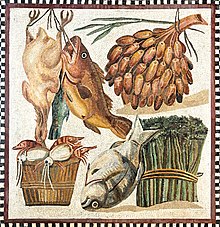
Most apartments in Rome lacked kitchens, though a charcoalbraziercould be used for rudimentary cookery.[317]Prepared food was sold at pubs and bars, inns, and food stalls (tabernae,cauponae,popinae,thermopolia).[318]Carryoutand restaurants were for the lower classes;fine diningappeared only at dinner parties in wealthy homes with achef(archimagirus) and kitchen staff,[319]or banquets hosted by social clubs (collegia).[320]
Most Romans consumed at least 70% of their dailycaloriesin the form of cereals andlegumes.[321]Puls(pottage) was considered the food of the Romans,[322]and could be elaborated to produce dishes similar topolentaorrisotto.[323]Urban populations and the military preferred bread.[321]By the reign ofAurelian,the state had begun to distribute theannonaas a daily ration of bread baked in state factories, and addedolive oil,wine, and pork to the dole.[324]
Roman literature focuses on the dining habits of the upper classes,[325]for whom the evening meal (cena) had important social functions.[326]Guests were entertained in a finely decorated dining room (triclinium) furnished with couches. By the late Republic, women dined, reclined, and drank wine along with men.[327]The poet Martial describes a dinner, beginning with thegustatio( "tasting" or "appetizer" ) salad. The main course waskid,beans, greens, a chicken, and leftover ham, followed by a dessert of fruit and wine.[328]Roman "foodies"indulged inwild game,fowlsuch aspeacockandflamingo,large fish (mulletwas especially prized), andshellfish.Luxury ingredients were imported from the far reaches of empire.[329]A book-length collection of Roman recipes is attributed toApicius,a name for several figures in antiquity that became synonymous with "gourmet".[330]
Refined cuisine could be moralized as a sign of either civilized progress or decadent decline.[331]Most often, because of the importance of landowning in Roman culture, produce—cereals, legumes, vegetables, and fruit—were considered more civilized foods than meat. TheMediterranean staplesofbread,wine,andoilweresacralizedby Roman Christianity, while Germanic meat consumption became a mark ofpaganism.[332]Some philosophers and Christians resisted the demands of the body and the pleasures of food, and adoptedfastingas an ideal.[333]Food became simpler in general as urban life in the West diminished and trade routes were disrupted;[334]the Church formally discouragedgluttony,[335]and hunting andpastoralismwere seen as simple and virtuous.[334]
Spectacles
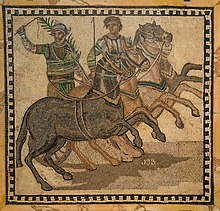
WhenJuvenalcomplained that the Roman people had exchanged their political liberty for "bread and circuses", he was referring to the state-provided grain dole and thecircenses,events held in the entertainment venue called acircus.The largest such venue in Rome was theCircus Maximus,the setting ofhorse races,chariot races,the equestrianTroy Game,staged beast hunts (venationes), athletic contests,gladiator combat,andhistorical re-enactments.From earliest times, severalreligious festivalshad featured games (ludi), primarily horse and chariot races (ludi circenses).[336]The races retained religious significance in connection with agriculture,initiation,and the cycle of birth and death.[q]
Under Augustus, public entertainments were presented on 77 days of the year; by the reign of Marcus Aurelius, this had expanded to 135.[338]Circus games were preceded by an elaborate parade (pompa circensis) that ended at the venue.[339]Competitive events were held also in smaller venues such as theamphitheatre,which became the characteristic Roman spectacle venue, and stadium. Greek-style athletics includedfootraces,boxing,wrestling,and thepancratium.[340]Aquatic displays, such as the mock sea battle (naumachia) and a form of "water ballet", were presented in engineered pools.[341]State-supportedtheatrical events(ludi scaenici) took place on temple steps or in grand stone theatres, or in the smaller enclosed theatre called anodeon.[342]
Circuses were the largest structure regularly built in the Roman world.[343]The Flavian Amphitheatre, better known as theColosseum,became the regular arena for blood sports in Rome.[344]ManyRoman amphitheatres,circusesandtheatresbuilt in cities outside Italy are visible as ruins today.[344]The local ruling elite were responsible for sponsoring spectacles and arena events, which both enhanced their status and drained their resources.[175]The physical arrangement of the amphitheatre represented the order of Roman society: the emperor in his opulent box; senators and equestrians in reserved advantageous seats; women seated at a remove from the action; slaves given the worst places, and everybody else in-between.[345]The crowd could call for an outcome by booing or cheering, but the emperor had the final say. Spectacles could quickly become sites of social and political protest, and emperors sometimes had to deploy force to put down crowd unrest, most notoriously at theNika riotsin 532.[346]

The chariot teams were known by thecolours they wore.Fan loyalty was fierce and at times erupted intosports riots.[348]Racing was perilous, but charioteers were among the most celebrated and well-compensated athletes.[349]Circuses were designed to ensure that no team had an unfair advantage and to minimize collisions (naufragia),[350]which were nonetheless frequent and satisfying to the crowd.[351]The races retained a magical aura through their early association withchthonicrituals: circus images were considered protective or lucky,curse tabletshave been found buried at the site of racetracks, and charioteers were often suspected of sorcery.[352]Chariot racing continued into the Byzantine period under imperial sponsorship, but the decline of cities in the 6th and 7th centuries led to its eventual demise.[343]
The Romans thought gladiator contests had originated withfuneral gamesandsacrifices.Some of the earlieststyles of gladiator fightinghad ethnic designations such as "Thracian"or" Gallic ".[353]The staged combats were consideredmunera,"services, offerings, benefactions", initially distinct from the festival games (ludi).[354]To mark the opening of the Colosseum,Tituspresented100 days of arena events,with 3,000 gladiators competing on a single day.[355]Roman fascination with gladiators is indicated by how widely they are depicted on mosaics, wall paintings, lamps, and in graffiti.[356]Gladiators were trained combatants who might be slaves, convicts, or free volunteers.[357]Death was not a necessary or even desirable outcome in matches between these highly skilled fighters, whose training was costly and time-consuming.[358]By contrast,noxiiwere convicts sentenced to the arena with little or no training, often unarmed, and with no expectation of survival; physical suffering and humiliation were considered appropriateretributive justice.[175]These executions were sometimes staged or ritualized as re-enactments ofmyths,and amphitheatres were equipped with elaboratestage machineryto create special effects.[175][359]
Modern scholars have found the pleasure Romans took in the "theatre of life and death"[360]difficult to understand.[361]Pliny the Youngerrationalized gladiator spectacles as good for the people, "to inspire them to face honourable wounds and despise death, by exhibiting love of glory and desire for victory".[362]Some Romans such asSenecawere critical of the brutal spectacles, but found virtue in the courage and dignity of the defeated fighter[363]—an attitude that finds its fullest expression with theChristians martyredin the arena. Tertullian considered deaths in the arena to be nothing more than a dressed-up form ofhuman sacrifice.[364]Evenmartyr literature,however, offers "detailed, indeed luxuriant, descriptions of bodily suffering",[365]and became a popular genre at times indistinguishable from fiction.[366]
Recreation
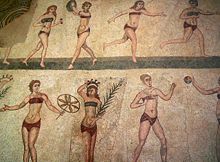
The singularludus,"play, game, sport, training", had a wide range of meanings such as "word play", "theatrical performance", "board game", "primary school", and even "gladiator training school" (as inLudus Magnus).[367]Activities for children and young people in the Empire includedhoop rollingandknucklebones(astragalior "jacks" ). Girls haddollsmade of wood,terracotta,and especiallybone and ivory.[368]Ball games includetrigonandharpastum.[369]People of all ages playedboard games,includinglatrunculi( "Raiders" ) andXII scripta( "Twelve Marks" ).[370]A game referred to asalea(dice) ortabula(the board) may have been similar tobackgammon.[371]Dicingas a form of gambling was disapproved of, but was a popular pastime during the festival of theSaturnalia.[citation needed]
After adolescence, most physical training for males was of a military nature. TheCampus Martiusoriginally was an exercise field where young men learned horsemanship and warfare. Hunting was also considered an appropriate pastime. According toPlutarch,conservative Romans disapproved of Greek-style athletics that promoted a fine body for its own sake, and condemnedNero's efforts to encourage Greek-style athletic games.[372]Some women trained as gymnasts and dancers, and a rare few asfemale gladiators.The "Bikini Girls" mosaic shows young women engaging in routines comparable torhythmic gymnastics.[r][374]Women were encouraged to maintain health through activities such as playing ball, swimming, walking, or reading aloud (as a breathing exercise).[375]
Clothing

In a status-conscious society like that of the Romans, clothing and personal adornment indicated the etiquette of interacting with the wearer.[376]Wearing the correct clothing reflected a society in good order.[377]There is little direct evidence of how Romans dressed in daily life, since portraiture may show the subject in clothing with symbolic value, and surviving textiles are rare.[378][379]
Thetogawas the distinctive national garment of the male citizen, but it was heavy and impractical, worn mainly for conducting political or court business and religious rites.[380][378]It was a "vast expanse" of semi-circular white wool that could not be put on and draped correctly without assistance.[380]The drapery became more intricate and structured over time.[381]Thetoga praetexta,with apurple or purplish-redstripe representing inviolability, was worn by children who had not come of age,curule magistrates,and state priests. Only the emperor could wear an all-purple toga (toga picta).[382]
Ordinary clothing was dark or colourful. The basic garment for all Romans, regardless of gender or wealth, was the simple sleevedtunic,with length differing by wearer.[383]The tunics of poor people and labouring slaves were made from coarse wool in natural, dull shades; finer tunics were made of lightweight wool or linen. A man of the senatorial or equestrian order wore a tunic with two purple stripes (clavi) woven vertically: the wider the stripe, the higher the wearer's status.[383]Other garments could be layered over the tunic. Common male attire also included cloaks and in some regionstrousers.[384]In the 2nd century, emperors and elite men are often portrayed wearing thepallium,an originally Greek mantle; women are also portrayed in the pallium.Tertullianconsidered the pallium an appropriate garment both for Christians, in contrast to the toga, and for educated people.[377][378][385]
Roman clothing styles changed over time.[386]In theDominate,clothing worn by both soldiers and bureaucrats became highly decorated with geometrical patterns, stylized plant motifs, and in more elaborate examples, human or animal figures.[387]Courtiers of the later Empire wore elaborate silk robes. The militarization of Roman society, and the waning of urban life, affected fashion: heavy military-style belts were worn by bureaucrats as well as soldiers, and the toga was abandoned,[388]replaced by the pallium as a garment embodying social unity.[389]
Arts
Greek arthad a profound influence on Roman art.[390]Public art—includingsculpture,monuments such asvictory columnsortriumphal arches,and the iconography oncoins—is often analysed for historical or ideological significance.[391]In the private sphere, artistic objects were made forreligious dedications,funerary commemoration,domestic use, and commerce.[392]The wealthy advertised their appreciation of culture through artwork anddecorative artsin their homes.[393]Despite the value placed on art, even famous artists were of low social status, partly as they worked with their hands.[394]
Portraiture
Portraiture, which survives mainly in sculpture, was the most copious form of imperial art. Portraits during the Augustan period utilizeclassical proportions,evolving later into a mixture of realism and idealism.[395]Republican portraits were characterized byverism,but as early as the 2nd century BC, Greekheroic nuditywas adopted for conquering generals.[396]Imperial portrait sculptures may model a mature head atop a youthful nude or semi-nude body with perfect musculature.[397]Clothed in the toga or military regalia, the body communicates rank or role, not individual characteristics.[398]Women of the emperor's family were often depicted as goddesses or divine personifications.[citation needed]
Portraiture in painting is represented primarily by theFayum mummy portraits,which evoke Egyptian and Roman traditions of commemorating the dead with realistic painting. Marble portrait sculpture were painted, but traces have rarely survived.[399]
Sculpture and sarcophagi

Examples of Roman sculpture survive abundantly, though often in damaged or fragmentary condition, including freestanding statuary in marble, bronze andterracotta,andreliefsfrom public buildings and monuments. Niches in amphitheatres were originally filled with statues,[400][401]as wereformal gardens.[402]Temples housed cult images of deities, often by famed sculptors.[403]
Elaborately carved marble and limestonesarcophagiare characteristic of the 2nd to 4th centuries.[404]Sarcophagus relief has been called the "richest single source of Roman iconography",[405]depictingmythological scenes[406]or Jewish/Christian imagery[407]as well as the deceased's life.
Painting
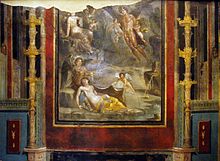
Initial Roman painting drew fromEtruscanandGreekmodels and techniques. Examples of Roman paintings can be found inpalaces,catacombsandvillas.Much of what is known of Roman painting is from the interior decoration of private homes, particularly as preserved by theeruption of Vesuvius.In addition to decorative borders and panels with geometric or vegetative motifs, wall painting depicts scenes from mythology and theatre, landscapes and gardens,spectacles,everyday life, anderotic art.[citation needed]
Mosaic

Mosaicsare among the most enduring of Romandecorative arts,and are found on floors and other architectural features. The most common is thetessellated mosaic,formed from uniform pieces(tesserae)of materials such as stone and glass.[409]Opus sectileis a related technique in which flat stone, usually coloured marble, is cut precisely into shapes from which geometric or figurative patterns are formed. This more difficult technique became especially popular for luxury surfaces in the 4th century (e.g. theBasilica of Junius Bassus).[410]
Figurativemosaics share many themes with painting, and in some cases use almost identicalcompositions.Geometric patterns and mythological scenes occur throughout the Empire. In North Africa, a particularly rich source of mosaics, homeowners often chose scenes of life on their estates, hunting, agriculture, and local wildlife.[408]Plentiful and major examples of Roman mosaics come also from present-day Turkey (particularly the (Antioch mosaics[411]), Italy, southern France, Spain, and Portugal.
Decorative arts
Decorative artsfor luxury consumers included fine pottery, silver and bronze vessels and implements, and glassware. Pottery manufacturing was economically important, as were the glass and metalworking industries. Imports stimulated new regional centres of production. Southern Gaul became a leading producer of the finer red-gloss pottery (terra sigillata) that was a major trade good in 1st-century Europe.[412]Glassblowingwas regarded by the Romans as originating in Syria in the 1st century BC, and by the 3rd century, Egypt and theRhinelandhad become noted for fine glass.[413]
-
Silvercup,from theBoscoreale Treasure(early 1st century AD)
-
Finely decorated Gallo-Romanterra sigillatabowl
-
Gold earrings with gemstones, 3rd century
-
Glasscage cupfrom the Rhineland, 4th century
Performing arts

In Roman tradition, borrowed from the Greeks, literary theatre was performed by all-male troupes that used face masks with exaggerated facial expressions to portray emotion. Female roles were played by men indrag(travesti). Roman literary theatre tradition is particularly well represented inLatin literatureby the tragedies ofSeneca.[citation needed]
More popular than literary theatre was the genre-defyingmimustheatre, which featured scripted scenarios with free improvisation, risqué language and sex scenes, action sequences, and political satire, along with dance, juggling, acrobatics, tightrope walking, striptease, anddancing bears.[414]Unlike literary theatre,mimuswas played without masks, and encouraged stylistic realism. Female roles were performed by women.[415]Mimuswas related topantomimus,an early form ofstory balletthat contained no spoken dialogue but rather a sunglibretto,often mythological, either tragic or comic.[416]

Although sometimes regarded as foreign,musicand dance existed in Rome from earliest times.[417]Music was customary at funerals, and thetibia,a woodwind instrument, was played at sacrifices.[418]Song(carmen)was integral to almost every social occasion. Music was thought to reflect the orderliness of the cosmos.[419]Various woodwinds and"brass" instrumentswere played, as werestringed instrumentssuch as thecithara,and percussion.[418]Thecornu,a long tubular metal wind instrument, was used for military signals and on parade.[418]These instruments spread throughout the provinces and are widely depicted in Roman art.[420]The hydraulic pipe organ(hydraulis)was "one of the most significant technical and musical achievements of antiquity", and accompanied gladiator games and events in the amphitheatre.[418]Although certain dances were seen at times as non-Roman or unmanly, dancing was embedded in religious rituals of archaic Rome.[421]Ecstatic dancing was a feature of themystery religions,particularly the cults ofCybele[422]andIsis.In the secular realm, dancing girls fromSyriaandCadizwere extremely popular.[423]
Likegladiators,entertainers were legallyinfames,technically free but little better than slaves. "Stars", however, could enjoy considerable wealth and celebrity, and mingled socially and often sexually with the elite.[424]Performers supported each other by forming guilds, and several memorials for theatre members survive.[425]Theatre and dance were often condemned byChristian polemicistsin the later Empire.[417][426]
Literacy, books, and education

Estimates of the averageliteracy raterange from 5 to over 30%.[427][428][429]The Roman obsession with documents and inscriptions indicates the value placed on the written word.[430][431][s]Laws and edicts were posted as well as read out. Illiterate Roman subjects could have a government scribe (scriba) read or write their official documents for them.[428][433]The military produced extensive written records.[434]TheBabylonian Talmuddeclared "if all seas were ink, all reeds were pen, all skies parchment, and all men scribes, they would be unable to set down the full scope of the Roman government's concerns".[435]
Numeracywas necessary for commerce.[431][436]Slaves were numerate and literate in significant numbers; some were highly educated.[437]Graffiti and low-quality inscriptions with misspellings andsolecismsindicate casual literacy among non-elites.[438][t][92]
The Romans had an extensivepriestly archive,and inscriptions appear throughout the Empire in connection withvotivesdedicated by ordinary people, as well as "magic spells"(e.g. theGreek Magical Papyri).[439]
Books were expensive, since each copy had to be written out on a papyrus roll (volumen) by scribes.[440]Thecodex—pages bound to a spine—was still a novelty in the 1st century,[441]but by the end of the 3rd century was replacing thevolumen.[442]Commercial book production was established by the late Republic,[443]and by the 1st century certain neighbourhoods of Rome and Western provincial cities were known for their bookshops.[444]The quality of editing varied wildly,[445]andplagiarismorforgerywere common, since there was nocopyright law.[443]

Collectors amassed personal libraries,[446]and a fine library was part of the cultivated leisure (otium) associated with the villa lifestyle.[447]Significant collections might attract "in-house" scholars,[448]and an individual benefactor might endow a community with a library (asPliny the Youngerdid inComum).[449]Imperial libraries were open to users on a limited basis, and represented aliterary canon.[450]Books considered subversive might be publicly burned,[451]andDomitiancrucified copyists for reproducing works deemed treasonous.[452]
Literary texts were often shared aloud at meals or with reading groups.[453]Public readings (recitationes) expanded from the 1st through the 3rd century, giving rise to "consumer literature" for entertainment.[454]Illustrated books, including erotica, were popular, but are poorly represented by extant fragments.[455]
Literacy began to decline during theCrisis of the Third Century.[456]The emperor Julian banned Christians from teaching the classical curriculum,[457]but theChurch Fathersand other Christians adopted Latin and Greek literature, philosophy and science in biblical interpretation.[458]As the Western Roman Empire declined, reading became rarer even for those within the Church hierarchy,[459]although it continued in theByzantine Empire.[460]
Education
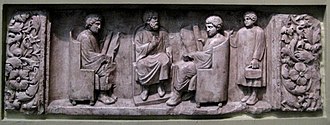
Traditional Roman education was moral and practical. Stories were meant to instil Roman values (mores maiorum). Parents were expected to act as role models, and working parents passed their skills to their children, who might also enter apprenticeships.[462]Young children were attended by apedagogue,usually a Greek slave or former slave,[463]who kept the child safe, taught self-discipline and public behaviour, attended class and helped with tutoring.[464]
Formal education was available only to families who could pay for it; lack of state support contributed to low literacy.[465]Primary education in reading, writing, and arithmetic might take place at home if parents hired or bought a teacher.[466]Other children attended "public" schools organized by a schoolmaster (ludimagister) paid by parents.[467]Vernae(homeborn slave children) might share in-home or public schooling.[468]Boys and girls received primary education generally from ages 7 to 12, but classes were not segregated by grade or age.[469]Most schools employedcorporal punishment.[470]For the socially ambitious, education in Greek as well as Latin was necessary.[471]Schools became more numerous during the Empire, increasing educational opportunities.[471]
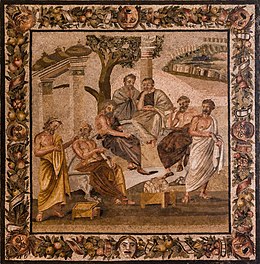
At the age of 14, upperclass males made theirrite of passageinto adulthood, and began to learn leadership roles through mentoring from a senior family member or family friend.[472]Higher education was provided bygrammaticiorrhetores.[473]Thegrammaticusor "grammarian" taught mainly Greek and Latin literature, with history, geography, philosophy or mathematics treated as explications of the text.[474]With the rise of Augustus, contemporary Latin authors such as Virgil and Livy also became part of the curriculum.[475]Therhetorwas a teacher of oratory or public speaking. The art of speaking (ars dicendi) was highly prized, andeloquentia( "speaking ability, eloquence" ) was considered the "glue" of civilized society.[476]Rhetoric was not so much a body of knowledge (though it required a command of theliterary canon[477]) as it was a mode of expression that distinguished those who held social power.[478]The ancient model of rhetorical training— "restraint, coolness under pressure, modesty, and good humour"[479]—endured into the 18th century as a Western educational ideal.[480]
In Latin,illiteratuscould mean both "unable to read and write" and "lacking in cultural awareness or sophistication".[481]Higher education promoted career advancement.[482]Urban elites throughout the Empire shared a literary culture imbued with Greek educational ideals (paideia).[483]Hellenistic cities sponsored schools of higher learning to express cultural achievement.[484]Young Roman men often went abroad to study rhetoric and philosophy, mostly to Athens. The curriculum in the East was more likely to include music and physical training.[485]On the Hellenistic model, Vespasianendowed chairsof grammar, Latin and Greek rhetoric, and philosophy at Rome, and gave secondary teachers special exemptions from taxes and legal penalties.[486]In the Eastern Empire,Berytus(present-dayBeirut) was unusual in offering a Latin education, and became famous for itsschool of Roman law.[487]The cultural movement known as theSecond Sophistic(1st–3rd century AD) promoted the assimilation of Greek and Roman social, educational, and esthetic values.[488]
Literate women ranged from cultured aristocrats to girls trained to becalligraphersandscribes.[489][490]The ideal woman in Augustan love poetry was educated and well-versed in the arts.[491]Education seems to have been standard for daughters of the senatorial and equestrian orders.[468]An educated wife was an asset for the socially ambitious household.[489]
Literature
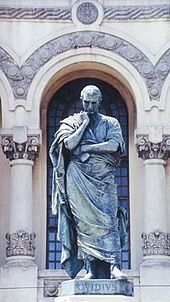
Literature under Augustus,along with that of the Republic, has been viewed as the "Golden Age" of Latin literature, embodyingclassical ideals.[492]The three most influential Classical Latin poets—Virgil,Horace,andOvid—belong to this period. Virgil'sAeneidwas a national epic in the manner of theHomeric epicsof Greece. Horace perfected the use ofGreek lyricmetresin Latin verse. Ovid's erotic poetry was enormously popular, but ran afoul of Augustan morality, contributing to his exile. Ovid'sMetamorphoseswove togetherGreco-Roman mythology;his versions ofGreek mythsbecame a primary source of laterclassical mythology,and his work was hugely influential onmedieval literature.[493]Latin writers were immersed inGreek literary traditions,and adapted its forms and content, but Romans regardedsatireas a genre in which they surpassed the Greeks. The earlyPrincipateproduced the satiristsPersiusandJuvenal.[citation needed]
The mid-1st through mid-2nd century has conventionally been called the "Silver Age"of Latin literature. The three leading writers—Seneca,Lucan,andPetronius—committed suicide after incurringNero's displeasure.Epigrammatistand social observerMartialand the epic poetStatius,whose poetry collectionSilvaeinfluencedRenaissance literature,[494]wrote during the reign ofDomitian.Other authors of the Silver Age includedPliny the Elder,author of the encyclopedicNatural History;his nephew,Pliny the Younger;and the historianTacitus.
The principal Latin prose author of theAugustan ageis thehistorianLivy,whose account ofRome's foundingbecame the most familiar version in modern-era literature.The Twelve CaesarsbySuetoniusis a primary source for imperial biography. Among Imperial historians who wrote in Greek areDionysius of Halicarnassus,Josephus,andCassius Dio.Other major Greek authors of the Empire include the biographerPlutarch,the geographerStrabo,and the rhetorician and satiristLucian.[citation needed]
From the 2nd to the 4th centuries, Christian authors were in active dialogue with theclassical tradition.Tertullianwas one of the earliest prose authors with a distinctly Christian voice. After theconversion of Constantine,Latin literature is dominated by the Christian perspective.[495]In the late 4th century,Jeromeproduced the Latin translation of the Bible that became authoritative as theVulgate.AugustineinThe City of God against the Pagansbuilds a vision of an eternal, spiritual Rome, a newimperium sine finethat will outlast the collapsing Empire.[citation needed]
In contrast to the unity of Classical Latin, the literary esthetic of late antiquity has atessellatedquality.[496]A continuing interest in the religious traditions of Rome prior to Christian dominion is found into the 5th century, with theSaturnaliaofMacrobiusandThe Marriage of Philology and MercuryofMartianus Capella.Prominent Latin poets of late antiquity includeAusonius,Prudentius,Claudian,andSidonius Apollinaris.[citation needed]
Religion
The Romans thought of themselves as highly religious, and attributed their success to their collective piety (pietas) and good relations with the gods (pax deorum). The archaic religion believed to have come from the earliestkings of Romewas the foundation of themos maiorum,"the way of the ancestors", central to Roman identity.[497]The priesthoods of the state religion were filled from the same pool of men who held public office, and thePontifex Maximuswas the emperor.[citation needed]
Roman religion was practical and contractual, based on the principle ofdo ut des,"I give that you might give". Religion depended on knowledge and thecorrect practiceof prayer, ritual, and sacrifice, not on faith or dogma, although Latin literature preserves learned speculation on the nature of the divine. For ordinary Romans, religion was a part of daily life.[498]Each home had a household shrine to offer prayers andlibationsto the family's domestic deities. Neighbourhood shrines and sacred places such as springs and groves dotted the city. TheRoman calendarwas structured around religious observances; as many as 135 days were devoted toreligious festivalsand games (ludi).[499]
In the wake of theRepublic's collapse,state religion adapted to support the new regime. Augustus justified one-man rule with a vast programme of religious revivalism and reform.Public vowsnow were directed at the wellbeing of the emperor. So-called "emperor worship" expanded on a grand scale the traditionalveneration of the ancestral deadand of theGenius,the divinetutelaryof every individual. Upon death, an emperor could be made a state divinity (divus) by vote of the Senate. TheRoman imperial cult,influenced byHellenistic ruler cult,became one of the major ways Rome advertised its presence in the provinces and cultivated shared cultural identity. Cultural precedent in the Eastern provinces facilitated a rapid dissemination of Imperial cult, extending as far asNajran,in present-daySaudi Arabia.[u]Rejection of the state religion became tantamount to treason. This was the context for Rome's conflict withChristianity,which Romans variously regarded as a form of atheism andsuperstitio.[citation needed]
The Romans are known for thegreat number of deitiesthey honoured. As the Romans extended their territories, their general policy was to promote stability among diverse peoples by absorbing local deities and cults rather than eradicating them,[v]building temples that framed local theology within Roman religion. Inscriptions throughout the Empire record the side-by-side worship of local and Roman deities, including dedications made by Romans to local gods.[501]By the height of the Empire, numeroussyncretic or reinterpreted godswere cultivated, among them cults ofCybele,Isis,Epona,and of solar gods such asMithrasandSol Invictus,found as far north asRoman Britain.Because Romans had never been obligated to cultivate one god or cult only,religious tolerancewas not an issue.[502]
Mystery religions,which offered initiates salvation in the afterlife, were a matter of personal choice, practiced in addition to one'sfamily ritesand public religion. The mysteries, however, involved exclusive oaths and secrecy, which conservative Romans viewed with suspicion as characteristic of "magic",conspiracy (coniuratio), and subversive activity. Thus, sporadic and sometimes brutal attempts were made to suppress religionists. In Gaul, the power of thedruidswas checked, first by forbidding Roman citizens to belong to the order, and then by banning druidism altogether. However, Celtic traditions were reinterpreted within the context of Imperial theology, and a newGallo-Roman religioncoalesced; its capital at theSanctuary of the Three Gaulsestablished precedent for Western cult as a form of Roman-provincial identity.[503]The monotheistic rigour ofJudaismposed difficulties for Roman policy that led at times to compromise and granting of special exemptions. Tertullian noted that Judaism, unlike Christianity, was considered areligio licita,"legitimate religion". TheJewish–Roman warsresulted from political as well as religious conflicts; thesiege of Jerusalemin 70 AD led to the sacking of the temple and the dispersal of Jewish political power (seeJewish diaspora).

Christianity emerged inRoman Judaeaas aJewish religious sectin the 1st century and graduallyspreadout ofJerusalemthroughout the Empire and beyond. Imperially authorized persecutions were limited and sporadic, with martyrdoms occurring most often under the authority of local officials.[504]Tacitusreports that after theGreat Fire of Romein AD 64, the emperor attempted to deflect blame from himself onto the Christians.[505]A major persecution occurred under the emperorDomitian[506]and apersecution in 177took place at Lugdunum, the Gallo-Roman religious capital. A letter fromPliny the Younger,governor ofBithynia,describes his persecution and executions of Christians.[507]TheDecian persecutionof 246–251 seriously threatened theChristian Church,but ultimately strengthened Christian defiance.[508]Diocletianundertook themost severe persecution of Christians,from 303 to 311.[citation needed]
From the 2nd century onward, theChurch Fatherscondemned the diverse religions practiced throughout the Empire as "pagan".[509]In the early 4th century,Constantine Ibecame the first emperor toconvert to Christianity.He supported the Church financially and made laws that favored it, but the new religion was already successful, having moved from less than 50,000 to over a million adherents between 150 and 250.[510]Constantine and his successors banned public sacrifice while tolerating other traditional practices. Constantine never engaged in apurge,[511]there were no "pagan martyrs" during his reign,[512]and people who had not converted to Christianity remained in important positions at court.[511]: 302 Julianattempted to revive traditional public sacrifice andHellenistic religion,but met Christian resistance and lack of popular support.[513]

Christians of the 4th century believed the conversion of Constantine showed that Christianity had triumphed over paganism (in Heaven) and little further action besides such rhetoric was necessary.[515]Thus, their focus washeresy.[516][517]According toPeter Brown,"In most areas, polytheists were not molested, and apart from a few ugly incidents of local violence, Jewish communities also enjoyed a century of stable, even privileged, existence".[517]: 641–643 [518]There were anti-pagan laws, but they were not generally enforced; through the 6th century, centers of paganism existed in Athens, Gaza, Alexandria, and elsewhere.[519]
According to recent Jewish scholarship, toleration of the Jews was maintained under Christian emperors.[520]This did not extend toheretics:[520]Theodosius I made multiple laws and acted against alternate forms of Christianity,[521]and heretics were persecuted and killed by both the government and the church throughout Late Antiquity. Non-Christians were not persecuted until the 6th century. Rome's original religious hierarchy and ritual influenced Christian forms,[522][523]and many pre-Christian practices survived in Christian festivals and local traditions.
Legacy
Several states claimed to be the Roman Empire's successor. TheHoly Roman Empirewas established in 800 whenPope Leo IIIcrownedCharlemagneasRoman emperor.TheRussian Tsardom,as inheritor of the Byzantine Empire'sOrthodox Christiantradition, counted itself theThird Rome(Constantinople having been the second), in accordance with the concept oftranslatio imperii.[524]The last Eastern Roman titular,Andreas Palaiologos,sold the title of Emperor of Constantinople toCharles VIII of France;upon Charles' death, Palaiologos reclaimed the title and on his death granted it toFerdinand and Isabellaand their successors, who never used it. When theOttomans,who based their state on the Byzantine model, took Constantinople in 1453,Mehmed IIestablished his capital there and claimed to sit on the throne of the Roman Empire.[525]He even launched aninvasion of Otrantowith the purpose of re-uniting the Empire, which was aborted by his death. In the medieval West, "Roman" came to mean the church and the Catholic Pope. The Greek formRomaioiremained attached to the Greek-speaking Christian population of the Byzantine Empire and is still used byGreeks.[526]
The Roman Empire's control of the Italian Peninsula influencedItalian nationalismand theunification of Italy(Risorgimento) in 1861.[527]Roman imperialism was claimed by fascist ideology, particularly by theItalian EmpireandNazi Germany.[citation needed]
In the United States, thefounderswere educated in theclassical tradition,[528]and used classical models forlandmarks in Washington, D.C..[529][530][531][532]The founders sawAthenian democracyandRoman republicanismas models for themixed constitution,but regarded the emperor as a figure of tyranny.[533]
See also
- Outline of ancient Rome
- List of political systems in France
- List of Roman dynasties
- Daqin( "GreatQin"), the ancient Chinese name for the Roman Empire; see alsoSino-Roman relations
- Imperial Italy
- Byzantine Empire under the Justinian dynasty
Notes
- ^Fig. 1. Regions east of theEuphratesriver were held only in the years 116–117.
- ^In 286, Emperor Diocletian divided the Roman Empire into two administrative units–EastandWest–an arrangement that periodically returned until the two halves were permanently divided in 395.[3]Although the halves were independent in practice, the Romans continued to consider the Roman Empire to be a single undivided state with two co-equal emperors until the fall of the western half in 476/480.[3]Although emperors at times governed from other cities (notablyMediolanumandRavennain the West andNicomediain the East), Rome remained thede jurecapital of the entire Roman Empire. In 330, EmperorConstantine Imade Constantinople a second and new capital of the empire ( "Second Rome" or "New Rome" ).[4][5][6][7][8][9]For a time, mostly over the course of the later decades of the fourth century, Rome continued to hold greater symbolic status on account of its greater antiquity as imperial capital.[10]From at least 361 onwards, senators belonging to thenew senatein Constantinople enjoyed the same status and privileges as senators of theRoman Senate,to which the new senate was largely identical.[11]By 450, Constantinople was much grander in size and adornment than Rome and unquestionably senior in status.[12]
- ^In 1204, the crusaders of theFourth Crusadecaptured Constantinople and established theLatin Empire.The city remained under foreign rule until 1261, when it was captured by theEmpire of Nicaea(a Byzantine/Roman successor state). Nicaea is usually considered the "legitimate" continuation of the Roman Empire during the "interregnum" 1204–1261 (over its rivals inTrebizondandThessalonica) since it managed to retake Constantinople.[13]Whether there was an interregnum at all is debatable given that the crusaders envisioned the Latin Empire to be the same empire as its predecessor (and not a new state).[14]
- ^Abbreviated "HS". Prices and values are usually expressed in sesterces.
- ^The Ottomans sometimes called their state the "Empire ofRûm"(Ottoman Turkish:دولت علنإه روم,lit. 'Exalted State of Rome'). In this sense, it could be argued that a "Roman" Empire survived until the early 20th century.[19]
- ^Prudentius(348–413) in particular Christianizes the theme in his poetry.[53]St. Augustine,however, distinguished between the secular and eternal "Rome" inThe City of God.See alsoFears, J. Rufus(1981), "The Cult of Jupiter and Roman Imperial Ideology",Aufstieg und Niedergang der römischen Welt,vol. II, p. 136,on how Classical Roman ideology influenced Christian Imperial doctrine,Bang, Peter Fibiger (2011), "The King of Kings: Universal Hegemony, Imperial Power, and a New Comparative History of Rome",The Roman Empire in Context: Historical and Comparative Perspectives,John Wiley & Sonsand the Greek concept of globalism (oikouménē).
- ^Its been called a state of bilingualism but that's only true of the educated and so Bruno Rochette suggests it's more appropriate as adiglossiabut concedes this still does not adequately explain it, as Greek was "high" against Latins "Super-high".[66]Latin experienced a period of spreading from the second century BCE, and especially in the western provinces, but not as much in the eastern provinces.[67]In the east, Greek was always the dominant language, a left over influence from theHellenistic periodthat predates the Empire.[68][69]
- ^Thecivis( "citizen" ) stands in explicit contrast to aperegrina,a foreign or non-Roman woman[116]In the form of legal marriage calledconubium,the father's legal status determined the child's, butconubiumrequired that both spouses be free citizens. A soldier, for instance, was banned from marrying while in service, but if he formed a long-term union with a local woman while stationed in the provinces, he could marry her legally after he was discharged, and any children they had would be considered the offspring of citizens—in effect granting the woman retroactive citizenship. The ban was in place from the time of Augustus until it was rescinded bySeptimius Severusin 197 AD.[117]
- ^The others areancient Athens,and in the modern eraBrazil,theCaribbean,and theUnited States
- ^That senator was Tiberius Claudius Gordianus[158]
- ^The relation of the equestrian order to the "public horse" and Roman cavalry parades and demonstrations (such as theLusus Troiae) is complex, but those who participated in the latter seem, for instance, to have been theequiteswho were accorded the high-status (and quite limited) seating at the theatre by theLex Roscia theatralis.Senators could not possess the "public horse".[160]
- ^Ancient Gades, in Roman Spain (nowCádiz), and Patavium, in the Celtic north of Italy (nowPadua), were atypically wealthy cities, and having 500 equestrians in one city was unusual.[162]
- ^This practice was established in the Republic; see for instance the case ofContrebian water rightsheard by G. Valerius Flaccus as governor ofHispaniain the 90s–80s BC.
- ^This was thevicesima libertatis,"the twentieth for freedom"[219]
- ^The college ofcentonariiis an elusive topic in scholarship, since they are also widely attested as urban firefighters.[275][276]HistorianJinyu Liusees them as "primarily tradesmen and/or manufacturers engaged in the production and distribution of low- or medium-quality woolen textiles and clothing, including felt and its products".[276]
- ^Julius Caesar first applied the Latin wordoppidumto this type of settlement, and even calledAvaricum(Bourges,France), a center of theBituriges,anurbs,"city". Archaeology indicates thatoppidawere centers of religion, trade (including import/export), and industrial production, walled for the purposes of defence, but they may not have been inhabited by concentrated populations year-round.[292]
- ^Such as theConsualiaand theOctober Horsesacrifice.[337]
- ^Scholars are divided in their relative emphasis on the athletic and dance elements of these exercises:Lee, H. (1984). "Athletics and the Bikini Girls from Piazza Armerina".Stadion.10:45–75.sees them as gymnasts, while Torelli thinks they are dancers at the games.[373]
- ^Clifford Andoposed the question as "what good would 'posted edicts' do in a world of low literacy?'.[432]
- ^Political slogans and obscenities are widely preserved as graffiti in Pompeii: Antonio Varone,Erotica Pompeiana: Love Inscriptions on the Walls of Pompeii( "L'Erma" di Bretschneider, 2002). Soldiers sometimes inscribedsling bulletswith aggressive messages: Phang, "Military Documents, Languages, and Literacy," p. 300.
- ^Thecaesareumat Najaran was possibly known later as the "Kaaba of Najran"[500]
- ^"This mentality," notes John T. Koch, "lay at the core of the genius of cultural assimilation which made the Roman Empire possible"; entry on "Interpretatio romana," inCeltic Culture: A Historical Encyclopedia(ABC-Clio, 2006), p. 974.
References
Citations
- ^Morley, Neville (2010).The Roman Empire: Roots of Imperialism.Pluto Press.ISBN978-0-7453-2870-6.;Diamond, Jared(2011).Collapse: How Societies Choose to Fail or Succeed(Revised ed.). Penguin. p. 13.ISBN978-1-1015-0200-6.
- ^Bennett (1997).
- ^abAncient Rome: The Definitive Visual History.Dorling Kindersley Limited. 2023. p. 276.ISBN978-0-2416-3575-9.Archivedfrom the original on 22 June 2023.Retrieved26 April2023.
- ^Classen, Albrecht (2010). "The changing shape of Europe".Handbook of Medieval Studies: Terms – Methods – Trends.Walter de Gruyter.ISBN978-3-1102-1558-8.Archivedfrom the original on 10 March 2024.Retrieved26 April2023.
Constantine the Great transferred the capital of the Roman Empire from Rome to the newly-founded city of Constantinople
- ^Price, Jonathan J.; Finkelberg, Margalit; Shahar, Yuval (2022).Rome: An Empire of Many Nations.Cambridge University Press. p. 19.ISBN978-1-0092-5622-3.Archivedfrom the original on 22 June 2023.Retrieved26 April2023.
the capital of the Empire was transferred from Rome to Constantinople in the fourth century
- ^Erdkamp, Paul (2013).The Cambridge Companion to Ancient Rome.Cambridge University Press. p. 202.ISBN978-0-5218-9629-0.
Constantine sounded the death knell for Rome as a vital political centre with the dedication of his new imperial capital at Constantinople
- ^Bjornlie, M. Shane (2013).Politics and Tradition Between Rome, Ravenna and Constantinople: A Study of Cassiodorus and the Variae, 527–554.Cambridge University Press. p. 41.ISBN978-1-1070-2840-1.Archivedfrom the original on 22 June 2023.Retrieved26 April2023.
As a new capital, Constantinople provided a stage for imperial prestige that did not depend on association with the traditions of the senatorial establishment at Rome
- ^Coffler, Gail H. (2004).Melville's Allusions to Religion: A Comprehensive Index and Glossary: A Comprehensive Index and Glossary.ABC-CLIO. p. 181.ISBN978-0-3130-7270-3.Archivedfrom the original on 22 June 2023.Retrieved26 April2023.
It became Constantinople, capital of the entire Roman Empire
- ^Maxwell, Kathleen (2016). "Art and Diplomacy in Late Thirteenth-century Constantinople: Paris 54 and the Union of Churches".Between Constantinople and Rome: An Illuminated Byzantine Gospel Book (Paris gr. 54) and the Union of Churches.Routledge.ISBN978-1-3519-5584-3.Archivedfrom the original on 22 June 2023.Retrieved26 April2023.
Constantine the Great, the emperor who moved the capital of the Roman Empire from Rome to Constantinople
- ^Grig, Lucy; Kelly, Gavin (2012).Two Romes: Rome and Constantinople in Late Antiquity.Oxford University Press. p. 237.ISBN978-0-1999-2118-8.Archivedfrom the original on 10 March 2024.Retrieved26 April2023.
- ^Loewenstein, K. (2012).The Governance of ROME.Springer. p. 443.ISBN978-9-4010-2400-6.Archivedfrom the original on 22 June 2023.Retrieved26 April2023.
- ^Harris, Jonathan (2009).Constantinople: Capital of Byzantium.A&C Black. p. 31.ISBN978-0-8264-3086-1.Archivedfrom the original on 22 June 2023.Retrieved26 April2023.
- ^Treadgold (1997),p. 734.
- ^Tricht, Filip Van (2011).The Latin Renovatio of Byzantium: The Empire of Constantinople (1204–1228).Brill. pp. 61–82.ISBN978-9-0042-0323-5.Archivedfrom the original on 6 April 2023.Retrieved26 April2023.
- ^abcdTaagepera, Rein(1979). "Size and Duration of Empires: Growth-Decline Curves, 600 B.C. to 600 A.D".Social Science History.3(3/4): 125.doi:10.2307/1170959.ISSN0145-5532.JSTOR1170959.
- ^abTurchin, Peter;Adams, Jonathan M.; Hall, Thomas D. (2006)."East-West Orientation of Historical Empires"(PDF).Journal of World-Systems Research.12(2): 222. Archived fromthe original(PDF)on 17 May 2016.Retrieved5 February2016.
- ^Durand, John D. (1977)."Historical Estimates of World Population: An Evaluation".Population and Development Review.3(3): 253–296.doi:10.2307/1971891.JSTOR1971891.Archivedfrom the original on 16 October 2019.Retrieved30 October2018.
- ^"Imperial Rome vs. Provincial Rome: What's The Difference?".TheCollector.7 October 2020.Retrieved16 May2024.
- ^Roy, Kaushik (2014).Military Transition in Early Modern Asia, 1400–1750: Cavalry, Guns, Government and Ships.Bloomsbury Studies in Military History. Bloomsbury Publishing. p. 37.ISBN978-1-7809-3800-4.
After the capture of Constantinople, the capital of the Byzantine Empire became the capital of the Ottoman Empire. The Osmanli Turks called their empire the Empire of Rum (Rome).
- ^Kelly (2007),pp. 4ff;Nicolet (1991),pp. 1, 15;Brennan, T. Corey(2000).The Praetorship in the Roman Republic.Oxford University Press. p. 605.Peachin (2011),pp. 39–40.
- ^abcPotter (2009),p. 179.
- ^Nicolet (1991),pp. 1, 15.
- ^abHekster, Olivier; Kaizer, Ted (16–19 April 2009). "Preface".Frontiers in the Roman World: Proceedings of the Ninth Workshop of the International Network Impact of Empire.Brill: viii.
- ^Lintott, Andrew(1999).The Constitution of the Roman Republic.Oxford University Press. p. 114.;Eder, W. (1993). "The Augustan Principate as Binding Link".Between Republic and Empire.University of California Press. p. 98.ISBN0-5200-8447-0.
- ^Richardson, John (2011). "Fines provincial".Frontiers in the Roman World.Brill. p. 10.
- ^Richardson (2011),pp. 1–2.
- ^Syme, Ronald(1939).The Roman Revolution.Oxford University Press. pp. 3–4.
- ^A. Fear; P. Liddel, eds. (2010)."The Glory of Italy and Rome's Universal Destiny in Strabo's Geographika".Historiae Mundi. Studies in Universal History.London: Duckworth. pp. 87–101.Retrieved20 November2021.
- ^Keaveney, Arthur (January 1987).Arthur Keaveney:Rome and the Unification of Italy.Croom Helm.ISBN9780709931218.Retrieved20 November2021.
- ^Billanovich, Giuseppe (2008).Libreria Universitaria Hoepli, Lezioni di filologia, Giuseppe Billanovich e Roberto Pesce:Corpus Iuris Civilis, Italia non erat provincia, sed domina provinciarum,Feltrinelli, p.363(in Italian). Roberto Pesce.ISBN9788896543092.Retrieved20 November2021.
- ^Bleicken, Jochen (15 October 2015).Italy: the absolute center of the Republic and the Roman Empire.Penguin UK.ISBN9780241003909.Retrieved20 November2021.
- ^Morcillo, Martha García (2010)."The Roman Italy:Rectrix MundiandOmnium Terrarum Parens".In A. Fear; P. Liddel (eds.).Historiae Mundi. Studies in Universal History.London: Bloomsbury.ISBN9781472519801.Retrieved20 November2021.
- ^Altri nomi e appellativi relazionati allo status dell'Italia in epoca romana(in Italian). Bloomsbury. 20 November 2013.ISBN9781472519801.Retrieved20 November2021.
- ^"Antico appellativo dell'Italia romana:Italia Omnium Terrarum Parens"(in Italian).Retrieved20 November2021.
- ^Boatwright, Mary T.(2000).Hadrian and the Cities of the Roman Empire.Princeton University Press. p. 4.
- ^Dio Cassius,Roman History,translated by Cary, E. (Loeb Classical Library edition, 1927 ed.), p.72.36.4
- ^Gibbon, Edward(1776),"The Decline And Fall in the West – Chapter 4",The History of the Decline And Fall of the Roman Empire,archivedfrom the original on 24 August 2017,retrieved27 June2017
- ^Goldsworthy (2009),p. 50.
- ^Brown, Peter(1971).The World of Late Antiquity.Harcourt Brace Jovanovich. p. 22.ISBN978-0-1519-8885-3.
- ^Goldsworthy (2009),pp. 405–415.
- ^Potter, David(2004).The Roman Empire at Bay.Routledge. pp. 296–298.ISBN978-0-4151-0057-1.
- ^Starr, Chester G.(1974) [1965].A History of the Ancient World(2nd ed.). Oxford University Press. pp. 670–678.ISBN978-0-1950-1814-1.
- ^Bury, John Bagnall(1923).History of the Later Roman Empire.Dover Books. pp. 295–297.Archivedfrom the original on 13 July 2021.Retrieved19 February2021.
- ^Bury (1923),pp. 312–313.
- ^abScholl, Christian (2017).Transcultural approaches to the concept of imperial rule in the Middle Ages.Peter Lang AG.ISBN978-3-6530-5232-9.
Odoacer, who dethroned the last Roman emperor Romulus Augustulus in 476, neither used the imperial insignia nor the colour purple, which was used by the emperor in Byzantium only.
- ^abPeter, Heather."The Fall of Rome".BBC.Archivedfrom the original on 28 March 2020.Retrieved11 February2020.
- ^Gibbon, Edward(1776)."Gothic Kingdom of Italy. – Part II."(ebook).In Widger, David (ed.).History Of The Decline And Fall Of The Roman Empire.Harper & Brothers.Archivedfrom the original on 30 August 2017.Retrieved11 February2020– via Project Gutenberg.
The patrician Orestes had married the daughter of Count Romulus, of Petovio in Noricum: the name of Augustus, notwithstanding the jealousy of power, was known at Aquileia as a familiar surname; and the appellations of the two great founders, of the city and of the monarchy, were thus strangely united in the last of their successors "," The life of this inoffensive youth was spared by the generous clemency of Odoacer; who dismissed him, with his whole family, from the Imperial palace.
- ^Gibbon, Edward(1776)."Gothic Kingdom of Italy. – Part II.".The Decline and Fall of the Roman Empire.Archivedfrom the original on 30 August 2017.Retrieved11 February2020– via Project Gutenberg.
The republic (they repeat that name without a blush) might safely confide in the civil and military virtues of Odoacer; and they humbly request, that the emperor would invest him with the title of Patrician, and the administration of the diocese of Italy....His vanity was gratified by the title of sole emperor, and by the statues erected to his honor in the several quarters of Rome;...He entertained a friendly, though ambiguous, correspondence with the patrician Odoacer; and he gratefully accepted the Imperial ensigns.
- ^Ozgen, Korkut."Mehmet II".TheOttomans.org.Archivedfrom the original on 30 April 2015.Retrieved3 April2007.;Cartwright, Mark (23 January 2018)."1453: The Fall of Constantinople".World History Encyclopedia.Archivedfrom the original on 12 April 2021.Retrieved11 February2020.
- ^Kelly (2007),p. 3.
- ^Nicolet (1991),p. 29.
- ^Nicolet (1991),p. 29;Virgil,p. 1.278;Mattingly, David J.(2011).Imperialism, Power, and Identity: Experiencing the Roman Empire.Princeton University Press. p. 15.;Moretti, G (1993), "The Other World and the 'Antipodes': The Myth of Unknown Countries between Antiquity and the Renaissance", in de Gruyter, Walter (ed.),The Classical Tradition and the Americas: European Images of the Americas,p. 257;Southern, Pat(2001).The Roman Empire from Severus to Constantine.Routledge. pp. 14–16.ISBN978-0-4152-3943-1.
- ^Mastrangelo, Marc (2008).The Roman Self in Late Antiquity: Prudentius and the Poetics of the Soul.Johns Hopkins University Press. pp. 73, 203.
- ^Mosley, Stephen (2010).The Environment in World History.Routledge. p.35.
- ^Nicolet (1991),pp. 7, 8.
- ^Nicolet (1991),pp. 9, 16.
- ^Nicolet (1991),pp. 10, 11.
- ^abSouthern (2001),pp. 14–16.
- ^abKelly (2007),p. 1.
- ^abMorris & Scheidel (2009),p. 184.
- ^Goldsmith, Raymond W. (2005). "An Estimate of the Size And Structure of the National Product of the Early Roman Empire".Review of Income and Wealth.30(3): 263–288.doi:10.1111/j.1475-4991.1984.tb00552.x.
- ^Scheidel, Walter (April 2006)."Population and demography"(PDF).Princeton/Stanford Working Papers in Classics.p. 9.Archived(PDF)from the original on 13 November 2018.Retrieved25 July2009.;Hanson, J. W.; Ortman, S. G. (2017). "A systematic method for estimating the populations of Greek and Roman settlements".Journal of Roman Archaeology.30:301–324.doi:10.1017/S1047759400074134.S2CID165770409.
- ^abBoardman (2000),p. 721.
- ^Hanson, J.W.; et al. (2017)."Urbanism and the division of labour in the Roman Empire".Journal of the Royal Society, Interface.14(136).doi:10.1098/rsif.2017.0367.PMC5721147.PMID29142013.
- ^Woolf, Greg, ed. (2003).Cambridge Illustrated History of the Roman World.Ivy Press. p. 340.;Opper, Thorsten (2008).Hadrian: Empire and Conflict.Harvard University Press. p. 64.;Fields, Nic (2003).Hadrian's Wall AD 122–410, which was, of course, at the bottom of Hadrian's garden.Osprey Publishing. p. 35.
- ^Rochette (2018),p. 123.
- ^Rochette (2012),pp. 562–563.
- ^Rochette (2018),p. 108.
- ^Millar, Fergus(2006).A Greek Roman Empire: Power and Belief under Theodosius II (408–450).University of California Press. p. 279.ISBN0-5209-4141-1.;Treadgold (1997),pp. 5–7
- ^Rochette (2018),p. 117.
- ^Wallace-Hadrill, Andrew (2010).Rome's cultural revolution(Repr. with corr ed.). Cambridge: Cambridge Univ. Press. p. 60.ISBN978-0-5217-2160-8.
- ^Rochette (1997, 2010, 1996, 1998, 2000, 2007), J. N. Adams (2003), Kearsley and Evans (2001), Binder (2000: 21–48), Rizakis (1995, 2008), Holford-Strevens (1993), Petersmann (1992), Dubuisson (1981, 1992a, 1992b), Millar (2006a: 84–93), Mullen (2011), Garcea (2019), Fournet (2019), Rapp (2019), Nocchi Macedo(2019), Pellizzari (2019), Rhoby (2019), Ghiretti (1996), García Domingo (1983), Zgusta (1980), Kaimio (1979a, 1979b), Hahn (1906), Mullen and James (2012), Stein (1915: 132–186) as cited inDickey, Eleanor (2023).Latin Loanwords in Ancient Greek: A Lexicon and Analysis(1st ed.). Cambridge University Press. p. 4.doi:10.1017/9781108888387.ISBN978-1-1088-8838-7.S2CID258920619.Archivedfrom the original on 9 February 2024.Retrieved17 August2023.
- ^Rochette (2012),p. 556;Adams (2003),p. 200.
- ^Feeney, Denis (2016).Beyond Greek: The Beginnings of Latin Literature.Harvard University Press.ISBN978-0-6744-9604-0.Archivedfrom the original on 4 October 2023.Retrieved17 August2023.
- ^Dickey, Eleanor (2023).Latin Loanwords in Ancient Greek: A Lexicon and Analysis.Cambridge University Press. p. 651.ISBN978-1-1088-9734-1.Archivedfrom the original on 4 October 2023.Retrieved17 August2023.
- ^Batstone, William W. (2006)."Literature".In Rosenstein, Nathan; Morstein-Marx, Robert (eds.).A Companion to the Roman Republic(1 ed.). Wiley. pp. 543–564.doi:10.1002/9780470996980.ch25.ISBN978-1-4051-0217-9.Archivedfrom the original on 18 July 2023.Retrieved17 August2023.
- ^Freeman (2000),p. 438.
- ^Cicero.In Catilinam.Vol. I 61 "recto"(Rylands Papyried.). p. 2.15.
- ^Adams 2003,pp. 188, 197;Freeman 2000,p. 394;Rochette 2012,p. 549
- ^Bloomer, W. Martin (1997).Latinity and Literary Society at Rome.University of Pennsylvania Press. p. 4.ISBN978-0-8122-3390-2.Archivedfrom the original on 4 October 2023.Retrieved17 August2023.
- ^Rochette (2018),p. 122.
- ^La Bua, Giuseppe (2019).Cicero and Roman education: the reception of the speeches and ancient scholarship.Cambridge (GB): Cambridge University Press. pp. 329ff.ISBN978-1-1070-6858-2.
- ^Adams (2003),p. 205.
- ^Rochette 2023,p. 263, 268;Rochette 2018,pp. 114–115, 118.
- ^Rochette (2018).
- ^Adams (2003),pp. 185–186, 205.
- ^abTreadgold (1997),pp. 5–7.
- ^Rochette (2018),pp. 108–109.
- ^Carlton, Charles Merritt (1973).A linguistic analysis of a collection of late Latin documents composed in Ravenna between A.D. 445–700.doi:10.1515/9783111636221.ISBN978-3-1116-3622-1.Archivedfrom the original on 10 March 2024.Retrieved17 August2023.
"page 37. According to Pei & Gaeng (1976: 76–81), the decisive moment came with the Islamic conquest of North Africa and Iberia, which was followed by numerous raids on land and by sea. All this had the effect of disrupting connections between the western Romance-speaking regions.
- ^abcMiles, Richard (2000). "Communicating Culture, Identity, and Power".Experiencing Power: Culture, Identity and Power in the Roman Empire.Routledge. pp. 58–60.ISBN0-4152-1285-5.
- ^Rochette (2012),p. 550;Zimmer, Stefan (2006). "Indo-European".Celtic Culture: A Historical Encyclopedia.ABC-Clio. p. 961.
- ^abCurchin, Leonard A. (1995). "Literacy in the Roman Provinces: Qualitative and Quantitative Data from Central Spain".The American Journal of Philology.116(3): 461–476 (464).doi:10.2307/295333.JSTOR295333.
- ^Rochette (2012),pp. 558–559.
- ^Adams (2003),p. 199.
- ^Hist. Franc.,book I, 32Veniens vero Arvernos, delubrum illud, quod Gallica lingua Vasso Galatæ vocant, incendit, diruit, atque subvertit.And coming to Clermont [to theArverni] he set on fire, overthrew and destroyed that shrine which they call Vasso Galatæ in the Gallic tongue,
- ^Hélix, Laurence (2011).Histoire de la langue française.Ellipses Edition Marketing S.A. p. 7.ISBN978-2-7298-6470-5.
Le déclin du Gaulois et sa disparition ne s'expliquent pas seulement par des pratiques culturelles spécifiques: Lorsque les Romains conduits par César envahirent la Gaule, au 1er siecle avant J.-C., celle-ci romanisa de manière progressive et profonde. Pendant près de 500 ans, la fameuse période gallo-romaine, le gaulois et le latin parlé coexistèrent; au VIe siècle encore; le temoignage de Grégoire de Tours atteste la survivance de la langue gauloise.
- ^Guiter, Henri (1995). "Sur le substrat gaulois dans la Romania". In Bochnakowa, Anna; Widlak, Stanislan (eds.).Munus amicitae. Studia linguistica in honorem Witoldi Manczak septuagenarii.Krakow.;Roegiest, Eugeen (2006).Vers les sources des langues romanes: Un itinéraire linguistique à travers la Romania.Acco. p. 83.;Savignac, Jean-Paul (2004).Dictionnaire Français-Gaulois.La Différence. p. 26.;Matasovic, Ranko (2007). "Insular Celtic as a Language Area".Papers from the Workshop within the Framework of the XIII International Congress of Celtic Studies.The Celtic Languages in Contact: 106.;Adams, J. N. (2007). "V – Regionalisms in provincial texts: Gaul".The Regional Diversification of Latin 200 BC – AD 600.pp.279–289.doi:10.1017/CBO9780511482977.ISBN978-0-5114-8297-7.
- ^Trask, R. L. (1997).The history of Basque.Routledge.ISBN0-4151-3116-2.OCLC34514667.
- ^Bard, Kathryn A. (2005).Encyclopedia of the Archaeology of Ancient Egypt.Routledge. pp. 252–254.ISBN978-1-1346-6525-9.;Bard, Kathryn A. (2015).An Introduction to the Archaeology of Ancient Egypt.John Wiley & Sons. p. 325.ISBN978-0-4706-7336-2.
- ^Peachin (2011),p. 12.
- ^Peachin (2011),p. 16.
- ^Peachin (2011),p. 9.
- ^abcdefgGarnsey, Peter; Saller, Richard.The Roman Empire: Economy, Society and Culture.University of California Press. pp. 107–111.
- ^Noreña, Carlos F. (2011).Imperial Ideals in the Roman West: Representation, Circulation, Power.Cambridge University Press. p. 7.
- ^Peachin (2011),pp. 4–5.
- ^Winterling (2009),pp. 11, 21.
- ^Saller, Richard P. (2002) [1982].Personal Patronage under the Early Empire.Cambridge University Press. pp. 123, 176, 183.;Duncan, Anne (2006).Performance and Identity in the Classical World.Cambridge University Press. p. 164.
- ^Reinhold, Meyer (2002).Studies in Classical History and Society.Oxford University Press. pp. 25ff, 42.
- ^Boardman (2000),p. 18.
- ^Peachin (2011),pp. 17, 20.
- ^Millar (2012),pp. 81–82.
- ^Carroll, Maureen (2006).Spirits of the Dead: Roman Funerary Commemoration in Western Europe.Oxford University Press. pp. 45–46.
- ^Frier & McGinn (2004),p. 14;Gaius,Institutiones1.9Digest1.5.3.
- ^Frier & McGinn (2004),pp. 31–32.
- ^Potter (2009),p. 177.
- ^Sherwin-White, A.N.(1979),Roman Citizenship,Oxford University Press, pp. 211, 268;Frier & McGinn (2004),pp. 31–32, 457
- ^Phang, Sara Elise (2001).The Marriage of Roman Soldiers (13 B.C.–A.D. 235): Law and Family in the Imperial Army.Brill. p. 2.;Southern, Pat(2006).The Roman Army: A Social and Institutional History.Oxford University Press. p. 144.
- ^Rawson (1987),p. 18.
- ^Frier & McGinn (2004),p. 461;Boardman (2000),p. 733.
- ^Woodhull, Margaret L. (2004). "Matronly Patrons in the Early Roman Empire: The Case of Salvia Postuma".Women's Influence on Classical Civilization.Routledge. p. 77.
- ^Frier & McGinn (2004),pp. 19–20.
- ^Cantarella, Eva(1987).Pandora's Daughters: The Role and Status of Women in Greek and Roman Antiquity.Johns Hopkins University Press. pp. 140–141.;Sullivan, J.P. (1979). "Martial's Sexual Attitudes".Philologus.123(1–2): 296.doi:10.1524/phil.1979.123.12.288.S2CID163347317.
- ^Rawson (1987),p. 15.
- ^Frier & McGinn (2004),pp. 19–20, 22.
- ^Treggiari, Susan (1991).Roman Marriage: 'Iusti Coniuges' from the Time of Cicero to the Time of Ulpian.Oxford University Press. pp. 258–259, 500–502.ISBN0-1981-4939-5.
- ^Johnston, David (1999). "3.3".Roman Law in Context.Cambridge University Press.;Frier & McGinn (2004),Ch. IV;Thomas, Yan (1991). "The Division of the Sexes in Roman Law".A History of Women from Ancient Goddesses to Christian Saints.Harvard University Press. p. 134.
- ^Severy, Beth (2002).Augustus and the Family at the Birth of the Empire.Routledge. p. 12.ISBN1-1343-9183-8.
- ^Severy (2002),p. 4.
- ^McGinn, Thomas A. J. (1991). "Concubinage and the Lex Iulia on Adultery".Transactions of the American Philological Association.121:335–375 (342).doi:10.2307/284457.JSTOR284457.;Mussbaum, Martha C.(2002). "The Incomplete Feminism of Musonius Rufus, Platonist, Stoic, and Roman".The Sleep of Reason: Erotic Experience and Sexual Ethics in Ancient Greece and Rome.University of Chicago Press. p. 305.,noting that custom "allowed much latitude for personal negotiation and gradual social change";Fantham, Elaine(2011). "Stuprum:Public Attitudes and Penalties for Sexual Offences in Republican Rome ".Roman Readings: Roman Response to Greek Literature from Plautus to Statius and Quintilian.Walter de Gruyter. p. 124.,citingPapinian,De adulteriisI andModestinus,Liber RegularumI.Cantarella, Eva(2002) [1988 (Italian), 1992].Bisexuality in the Ancient World.Yale University Press. p. 104.;Edwards (2007),pp. 34–35.
- ^Grace, Angela (28 August 2015)."Fecunditas, Sterilitas, and the Politics of Reproduction at Rome".York Space.
- ^abBradley (1994),p. 12.
- ^Bradley (1994),p. 15.
- ^Harris (1999),pp. 62–75;Taylor, Timothy (2010). "Believing the ancients: Quantitative and qualitative dimensions of slavery and the slave trade in later prehistoric Eurasia".World Archaeology.33(1): 27–43.arXiv:0706.4406.doi:10.1080/00438240120047618.S2CID162250553.
- ^Harper, Kyle (2011).Slavery in the Late Roman World, AD 275–425.Cambridge University Press. pp. 10–16.
- ^Frier & McGinn (2004),p. 7.
- ^McGinn, Thomas A.J. (1998).Prostitution, Sexuality and the Law in Ancient Rome.Oxford University Press. p. 314.ISBN0-1951-6132-7.;Gardner, Jane F. (1991).Women in Roman Law and Society.Indiana University Press. p. 119.
- ^Frier & McGinn (2004),pp. 31–33.
- ^Frier & McGinn (2004),p. 21.
- ^Gamauf, Richard (2009). "Slaves doing business: The role of Roman law in the economy of a Roman household".European Review of History.16(3): 331–346.doi:10.1080/13507480902916837.S2CID145609520.
- ^Bradley (1994),pp. 2–3.
- ^Bradley (1994),p. 10.
- ^Fuhrmann, C. J. (2012).Policing the Roman Empire: Soldiers, Administration, and Public Order.Oxford University Press. pp. 21–41.ISBN978-0-1997-3784-0.
- ^McGinn (1998),pp. 288ff.
- ^Abusch, Ra'anan (2003). "Circumcision and Castration under Roman Law in the Early Empire".The Covenant of Circumcision: New Perspectives on an Ancient Jewish Rite.Brandeis University Press. pp. 77–78.;Schäfer, Peter (2003) [1983].The History of the Jews in the Greco-Roman World.Routledge. p. 150.
- ^Frier & McGinn (2004),p. 15;Goodwin, Stefan (2009).Africa in Europe: Antiquity into the Age of Global Expansion.Vol. 1. Lexington Books. p. 41.ISBN978-0-7391-1726-2.
Roman slavery was a nonracist and fluid system
- ^Santosuosso, Antonio(2001).Storming the Heavens: Soldiers, Emperors and Civilians in the Roman Empire.Westview Press. pp. 43–44.ISBN0-8133-3523-X.
- ^Noy, David (2000).Foreigners at Rome: Citizens and Strangers.Duckworth with the Classical Press of Wales.ISBN978-0-7156-2952-9.
- ^Harper, James (1972). "Slaves and Freedmen in Imperial Rome".American Journal of Philology.93(2): 341–342.doi:10.2307/293259.JSTOR293259.
- ^Harris (1999).
- ^Rawson (1987),pp. 186–188, 190;Bradley (1994),pp. 34, 48–50
- ^Millar, Fergus(2002) [1998].The Crowd in Rome in the Late Republic.University of Michigan. pp. 23, 209.ISBN0-4720-8878-5.
- ^Mouritsen, Henrik (2011).The Freedman in the Roman World.Cambridge University Press. p. 36.
- ^abBerger, Adolf (1991) [1953]. "libertus".Encyclopedic Dictionary of Roman Law.American Philological Society. p. 564.
- ^Boardman (2000),pp. 217–218;Syme, Ronald(1999).Provincial at Rome: and Rome and the Balkans 80 BC – AD 14.University of Exeter Press. pp. 12–13.ISBN0-8598-9632-3.
- ^Boardman (2000),pp. 215, 221–222;Millar (2012),p. 88, The standard complement of 600 was flexible; twentyquaestors,for instance, held office each year and were thus admitted to the Senate regardless of whether there were "open" seats
- ^abMillar (2012),p. 88.
- ^Boardman (2000),pp. 218–219.
- ^Boardman (2000),p. 219.
- ^MacMullen, Ramsay (1966). "Provincial Languages in the Roman Empire".The American Journal of Philology.87(1): 1–17.doi:10.2307/292973.JSTOR292973.
- ^Wiseman (1970),pp. 78–79.
- ^Wiseman (1970),pp. 71–72, 76.
- ^Strabo3.169, 5.213
- ^Wiseman (1970),pp. 75–76, 78.
- ^Fear, Andrew (2007). "War and Society".The Cambridge History of Greek and Roman Warfare: Rome from the Late Republic to the Late Empire.Vol. 2. Cambridge University Press. pp. 214–215.ISBN978-0-5217-8274-6.;Bennett (1997),p. 5.
- ^Morris & Scheidel (2009),p. 188;Millar (2012),pp. 87–88.
- ^Millar (2012),p. 96.
- ^Liebeschuetz, Wolfgang (2001). "The End of the Ancient City".The City in Late Antiquity.Taylor & Francis. pp. 26–27.
- ^Millar (2012),p. 90, calls them "status-appellations".
- ^Millar (2012),p. 91.
- ^Millar (2012),p. 90.
- ^abcVerboven, Koenraad (2007)."The Associative Order: Status and Ethos among Roman Businessmen in Late Republic and Early Empire".Athenaeum.95:870–872.hdl:1854/LU-395187.Archivedfrom the original on 3 November 2018.Retrieved13 January2017.;Peachin (2011),pp. 153–154.
- ^Peachin (2011),pp. 153–154;Perkins, Judith (2009).Early Christian and Judicial Bodies.Walter de Gruyter. pp. 245–246.;Peachin (2011),p. 475.
- ^Peachin (2011),pp. 153–154.
- ^Gaughan, Judy E. (2010).Murder Was Not a Crime: Homicide and Power in the Roman Republic.University of Texas Press. p. 91.ISBN978-0-2927-2567-6.;Kelly, Gordon P. (2006).A History of Exile in the Roman Republic.Cambridge University Press. p. 8.ISBN0-5218-4860-1.
- ^abcdColeman, K. M. (2012). "Fatal Charades: Roman Executions Staged as Mythological Enactments".Journal of Roman Studies.80:44–73.doi:10.2307/300280.JSTOR300280.S2CID163071557.
- ^Peachin (2011),pp. 153–154;Robinson, O.F. (2007).Penal Practice and Penal Policy in Ancient Rome.Routledge. p. 108.
- ^Bohec (2000),p. 8.
- ^Bohec (2000),pp. 14–15.
- ^Plutarch,MoraliaMoralia 813c and 814c;Potter (2009),pp. 181–182;Luttwak, Edward(1979) [1976].The Grand Strategy of the Roman Empire.Johns Hopkins University Press. p. 30.ISBN0-8018-2158-4.
- ^Potter (2009),p. 184.
- ^Potter (2009),p. 181.
- ^Smith, William (1875).A Dictionary of Greek and Roman Antiquities.John Murray. pp. 105–106.Archivedfrom the original on 13 July 2021.Retrieved11 February2020.
- ^Abbott (1901),p. 354.
- ^Abbott (1901),p. 345.
- ^Abbott (1901),p. 341.
- ^Millar, Fergus(2004). "Emperors at Work".Rome, the Greek World, and the East: Government, Society, and Culture in the Roman Empire.Vol. 2. University of North Carolina Press. pp. 3–22, especially 4, 20.ISBN0-8078-5520-0.
- ^Boardman (2000),pp. 195ff.
- ^Boardman (2000),pp. 205–209.
- ^Boardman (2000),pp. 202–203, 205, 210.
- ^Boardman (2000),p. 211.
- ^Boardman (2000),p. 212.
- ^abMillar (2012),p. 76.
- ^Boardman (2000),p. 215.
- ^Boardman (2000),p. 721;Winterling (2009),p. 16.
- ^Goldsworthy (2003),p. 80.
- ^Winterling (2009),p. 16.
- ^Tignor, Robert; et al. (2011).Worlds Together, Worlds Apart: The History of the World(3rd ed.). W.W. Norton & Company. p.262.ISBN978-0-3939-3492-2.
- ^Edmondson (1996),pp. 111–112.
- ^Bohec (2000),p. 9.
- ^Hekster, Olivier J. (2007). "Fighting for Rome: The Emperor as a Military Leader".Impact of the Roman Army (200 BC–AD 476).Brill. p. 96.
- ^Roth, J. (1994). "The Size and Organization of the Roman Imperial Legion".Historia.43(3): 346–362.
- ^Goldsworthy (2003),p. 183.
- ^abMorris & Scheidel (2009),p. 196.
- ^Penrose, Jane (2005). "9:The Romans".Rome and Her Enemies: An Empire Created and Destroyed by War.Bloomsbury US. p. 183.ISBN978-1-8417-6932-5.
Section 3:Early Empire 27 BC–AD 235
- ^TacitusAnnalesIV.5
- ^Goldsworthy (2003),p. 51.
- ^Connolly, Peter (1986). "A Reconstruction of a Roman Saddle".Britannia.17:353–355.doi:10.2307/526559.JSTOR526559.S2CID164155025.;Connolly, Peter; Van Driel-Murray, Carol (1991). "The Roman Cavalry Saddle".Britannia.22:33–50.doi:10.2307/526629.JSTOR526629.S2CID161535316.
- ^Goldsworthy (2003),p. 114.
- ^Potter (2009),p. 183.
- ^Potter (2009),pp. 177–179, Most government records that are preserved come from Roman Egypt, where the climate preserved the papyri..
- ^Potter (2009),p. 179, The exclusion of Egypt from the senatorial provinces dates to the rise of Octavian before he became Augustus: Egypt had been the stronghold of his last opposition,Mark Antonyand his allyCleopatra..
- ^abcPotter (2009),p. 180.
- ^Potter (2009),pp. 179, 187.
- ^Potter (2009),p. 180;Fuhrmann (2012),pp. 197, 214, 224
- ^abPotter (2009),pp. 184–185.
- ^Bozeman, Adda B. (2010).Politics and Culture in International History from the Ancient Near East to the Opening of the Modern Age(2nd ed.). Transaction Publishers. pp. 208–220.
- ^Digeser, Elizabeth DePalma(2000).The Making of a Christian Empire: Lactantius and Rome.Cornell University Press. p. 53.
- ^Morris & Scheidel (2009),p. 183.
- ^abcdePotter (2009),p. 187.
- ^Potter (2009),pp. 185–187.
- ^Morris & Scheidel (2009),p. 184;Potter (2009),p. 185.
- ^Potter (2009),p. 185.
- ^abPotter (2009),p. 188.
- ^Potter (2009),p. 186.
- ^Cassius Dio55.31.4.
- ^Tacitus,Annales13.31.2.
- ^Potter (2009),pp. 286, 295.
- ^Potter (2009),p. 286.
- ^abcPotter (2009),p. 285.
- ^Potter (2009),p. 292.
- ^Potter (2009),pp. 285–286, 296ff.
- ^Potter (2009),p. 296.
- ^Scheidel, Walter;Morris, Ian;Saller, Richard, eds. (2007).The Cambridge Economic History of the Greco-Roman World.Cambridge University Press.ISBN978-0-5217-8053-7.
- ^Lo Cascio, Elio;Malanima, Paolo(2009)."GDP in Pre-Modern Agrarian Economies (1–1820 AD). A Revision of the Estimates".Rivista di Storia Economica.25(3): 391–420 (391–401).Archivedfrom the original on 16 January 2017.Retrieved13 January2017.
- ^Maddison, Angus(2007).Contours of the World Economy, 1–2030 AD. Essays in Macro-Economic History.Oxford University Press. pp. 47–51.ISBN978-0-1992-2721-1.
- ^Dyson, Stephen L. (1992).Community and Society in Roman Italy.Johns Hopkins University Press. p. 177.ISBN0-8018-4175-5.quotingPacker, J.E.Middle and Lower Class Housing in Pompeii and Herculaneum: A Preliminary Survey, "In Neue Forschung in Pompeji.pp. 133–142.
- ^Scheidel, Walter;Friesen, Steven J. (2010)."The Size of the Economy and the Distribution of Income in the Roman Empire"(PDF).Journal of Roman Studies.99:61–91.doi:10.3815/007543509789745223.S2CID202968244.Archived(PDF)from the original on 13 November 2018.Retrieved12 January2017.
- ^Fears, J. Rufus(1981). "The Theology of Victory at Rome: Approaches and Problem".Aufstieg und Niedergang der römischen Welt.Vol. II.17.2. pp. 752, 824.,Fears, J. Rufus(1981). "The Cult of Virtues and Roman Imperial Ideology".Aufstieg und Niedergang der römischen Welt.Vol. II.17.2. p. 908.
- ^abKessler, David; Temin, Peter (2010). "Money and Prices in the Early Roman Empire".The Monetary Systems of the Greeks and Romans.Oxford University Press.
- ^abcdHarl, Kenneth W. (19 June 1996).Coinage in the Roman Economy, 300 B.C. to A.D. 700.JHU Press. pp. 125–135.ISBN978-0-8018-5291-6.
- ^Bowman, Garnsey & Cameron (2005),p. 333.
- ^Wells, Colin (1984).The Roman Empire.Harvard University Press. p. 8.
- ^abcdefHarris (2010).
- ^Scheidel, Walter (2009). "The Monetary Systems of the Han and Roman Empires". In Scheidel, Walter (ed.).Rome and China. Comparative Perspectives on Ancient World Empires.Oxford University Press. pp. 137–207 (205).ISBN978-0-1953-3690-0.
- ^Harris (2010);Andreau, Jean (1999).Banking and Business in the Roman World.Cambridge University Press. p. 2.
- ^Tacitus,Annales6.17.3.
- ^Duncan-Jones (1994),pp. 3–4.
- ^Silva-Sánchez, Noemí; Armada, Xose-Lois (7 March 2023)."Environmental Impact of Roman Mining and Metallurgy and Its Correlation with the Archaeological Evidence: A European Perspective".Environmental Archaeology:11.doi:10.1080/14614103.2023.2181295.ISSN1461-4103.
- ^Silva-Sánchez, Noemí; Armada, Xose-Lois (7 March 2023)."Environmental Impact of Roman Mining and Metallurgy and Its Correlation with the Archaeological Evidence: A European Perspective".Environmental Archaeology:15.doi:10.1080/14614103.2023.2181295.ISSN1461-4103.
- ^Edmondson, J. C. (1989)."Mining in the Later Roman Empire and beyond: Continuity or Disruption?".The Journal of Roman Studies.79:84–102.doi:10.2307/301182.ISSN0075-4358.JSTOR301182.S2CID161980467.
- ^https://livrepository.liverpool.ac.uk/3066254/3/Hirt%20Warwick%20Publ.%20III%20%28revised%29.pdf
- ^Wilson, Andrew (2002). "Machines, Power and the Ancient Economy".The Journal of Roman Studies.92:1–32.doi:10.2307/3184857.JSTOR3184857.S2CID154629776.
- ^Craddock, Paul T. (2008). "Mining and Metallurgy". InOleson, John Peter(ed.).The Oxford Handbook of Engineering and Technology in the Classical World.Oxford University Press. p. 108.ISBN978-0-1951-8731-1.;Sim, David; Ridge, Isabel (2002).Iron for the Eagles. The Iron Industry of Roman Britain.Tempus. p. 23.ISBN0-7524-1900-5.;Healy, John F. (1978).Mining and Metallurgy in the Greek and Roman World.Thames and Hudson. p. 196.ISBN0-5004-0035-0.Assumes a productive capacity ofc. 1.5 kgper capita.
- ^Hong, S.; Candelone, J.-P.; Patterson, C. C.; Boutron, C. F. (1996). "History of Ancient Copper Smelting Pollution During Roman and Medieval Times Recorded in Greenland Ice".Science.272(5259): 246.Bibcode:1996Sci...272..246H.doi:10.1126/science.272.5259.246.S2CID176767223.
- ^Hong, S; Candelone, J. P.; Patterson, C. C.; Boutron, C. F. (1994)."Greenland ice evidence of hemispheric lead pollution two millennia ago by greek and roman civilizations"(PDF).Science.265(5180): 1841–1843.Bibcode:1994Sci...265.1841H.doi:10.1126/science.265.5180.1841.PMID17797222.S2CID45080402.Archived(PDF)from the original on 29 April 2019.Retrieved12 January2017.
- ^abDe Callataÿ, François (2015). "The Graeco-Roman economy in the super long-run: Lead, copper, and shipwrecks".Journal of Roman Archaeology.18:361–372.doi:10.1017/S104775940000742X.S2CID232346123.
- ^Settle, D. M.; Patterson, C. C. (1980). "Lead in albacore: Guide to lead pollution in Americans".Science.207(4436): 1167–1176.Bibcode:1980Sci...207.1167S.doi:10.1126/science.6986654.PMID6986654.
- ^Patterson, C. C. (1972). "Silver Stocks and Losses in Ancient and Medieval Times".The Economic History Review.25(2): 205–235 (tables 2, 6).doi:10.1111/j.1468-0289.1972.tb02173.x.
- ^Morris & Scheidel (2009),p. 197.
- ^Greene, Kevin (1990).The Archaeology of the Roman Economy.University of California Press. p. 17.ISBN978-0-5200-7401-9.
- ^Boardman (2000),p. 714.
- ^Ulrich, Roger Bradley (2007).Roman Woodworking.Yale University Press. pp. 1–2.ISBN978-0-3001-0341-0.
- ^Van Tilburg, Cornelis (2007).Traffic and Congestion in the Roman Empire.Routledge. p. 33.
- ^abcStambaugh (1988),p. 253.
- ^Ray Laurence,"Land Transport in Roman Italy: Costs, Practice and the Economy", inTrade, Traders and the Ancient City(Routledge, 1998), p. 129.
- ^Boardman (2000),p. 713.
- ^Boardman (2000),p. 710.
- ^Boardman (2000),pp. 717–729.
- ^Bowman, Garnsey & Cameron (2005),p. 404;Boardman (2000),p. 719.
- ^Gagarin (2010),p. 323.
- ^Temin, Peter (2004). "The Labor Market of the Early Roman Empire".Journal of Interdisciplinary History.34(4): 513–538.doi:10.1162/002219504773512525.S2CID33380115.
- ^Jones (1960),pp. 184–185.
- ^abJones (1960),p. 192.
- ^Jones (1960),pp. 190–191.
- ^Vout (2009),p. 212.
- ^abLiu, Jinyu(2009).Collegia Centonariorum: The Guilds of Textile Dealers in the Roman West.Brill.
- ^MacDonald, William L.(1982).The Architecture of the Roman Empire.Yale University Press. fig. 131B.;Lechtman, H. N.; Hobbs, L. W. (1987). "Roman Concrete and the Roman Architectural Revolution".Ceramics and Civilization.3:81–128.
- ^"Apollodorus of Damascus".Britannica.13 February 2024.Archivedfrom the original on 21 May 2008.Retrieved26 August2012.;Sarton, George (1936). "The Unity and Diversity of the Mediterranean World".Osiris.2:406–463 (430).doi:10.1086/368462.S2CID143379839.;Calcani, Giuliana; Abdulkarim, Maamoun (2003).Apollodorus of Damascus and Trajan's Column: From Tradition to Project.L'Erma di Bretschneider. p. 11.ISBN978-8-8826-5233-3.;Yan, Hong-Sen; Ceccarelli, Marco (2009).International Symposium on History of Machines and Mechanisms: Proceedings of HMM 2008.Springer.p. 86.ISBN978-1-4020-9484-2.
- ^Smith, Norman (1970). "The Roman Dams of Subiaco".Technology and Culture.11(1): 58–68.doi:10.2307/3102810.JSTOR3102810.S2CID111915102.;Smith, Norman (1971).A History of Dams.Peter Davies. p. 26.ISBN978-0-4321-5090-0.;Schnitter, Niklaus (1978). "Römische Talsperren".Antike Welt.8(2): 25–32 (28).
- ^Chandler, Fiona (2001).The Usborne Internet Linked Encyclopedia of the Roman World.Usborne Publishing. p. 80.
- ^Forman, Joan (1975).The Romans.Macdonald Educational. p. 34.
- ^Crow, J. (2007). "Earth, walls and water in Late Antique Constantinople". In Lavan, L.; Zanini, E.; Sarantis, A. (eds.).Technology in Transition AD 300–650.Brill.
- ^Greene, Kevin (1990).The Archaeology of the Roman Economy.University of California Press. p. 39.ISBN978-0-5200-7401-9.
- ^Jones & Bird (2012),pp. 59–74.
- ^Ritti, Tullia; Grewe, Klaus; Kessener, Paul (2007). "A Relief of a Water-powered Stone Saw Mill on a Sarcophagus at Hierapolis and its Implications".Journal of Roman Archaeology.20:138–163 (156, fn. 74).doi:10.1017/S1047759400005341.S2CID161937987.
- ^Potter (2009),p. 192.
- ^abcRehak, Paul (2006).Imperium and Cosmos: Augustus and the Northern Campus Martius.University of Wisconsin Press. pp. 4–8.
- ^Stambaugh (1988),pp. 23ff, 244.
- ^Raja, Rubina(2012).Urban Development and Regional Identity in the Eastern Roman Provinces 50 BC–AD 250.Museum Tusculanum Press. pp. 215–218.;Sperber, Daniel (1998).The City in Roman Palestine.Oxford University Press.
- ^Stambaugh (1988),pp. 252, 253.
- ^abLongfellow, Brenda (2011).Roman Imperialism and Civic Patronage: Form, Meaning and Ideology in Monumental Fountain Complexes.Cambridge University Press. pp. 1–2.ISBN978-0-5211-9493-8.
- ^Harding, D.W. (2007).The Archaeology of Celtic Art.Routledge. pp. 211–212.ISBN978-1-1342-6464-3.;Collis, John (2000). "'Celtic' Oppida ".A Comparative Study of Thirty City-state Cultures.Danske Videnskabernes Selskab. pp. 229–238.;Celtic Chiefdom, Celtic State: The Evolution of Complex Social Systems.Cambridge University Press. 1999 [1995]. p. 61.
- ^Potter (2009),p. 192;Virgil,p. 6.852
- ^Potter (2009),pp. 185–186.
- ^Jones (2003).
- ^Evans, Harry B. (1994).Water Distribution in Ancient Rome.University of Michigan Press. pp. 9–10.
- ^Peachin (2011),p. 366.
- ^abFagan, Garrett G. (2001)."The Genesis of the Roman Public Bath: Recent Approaches and Future Directions"(PDF).American Journal of Archaeology.105(3): 403–426.doi:10.2307/507363.JSTOR507363.S2CID31943417.Archived fromthe original(PDF)on 24 February 2021.Retrieved12 January2017.
- ^Ward, Roy Bowen (1992). "Women in Roman Baths".Harvard Theological Review.85(2): 125–147.doi:10.1017/S0017816000028820.S2CID161983440.
- ^Clarke (1991),pp. 1–2.
- ^Clarke (1991),pp. 11–12.
- ^Clarke (1991),p. 2.
- ^Stambaugh (1988),pp. 144, 147;Clarke (1991),pp. 12, 17, 22ff
- ^Gazda, Elaine K. (1991). "Introduction".Roman Art in the Private Sphere: Architecture and Décor of the Domus, Villa, and Insula.University of Michigan Press. p. 9.ISBN0-4721-0196-X.
- ^abClarke (1991),p. 19.
- ^Jashemski, Wilhelmina Feemster; Meyer, Frederick G. (2002).The Natural History of Pompeii.Cambridge University Press.ISBN978-0-5218-0054-9.
- ^abcdefMorris & Scheidel (2009),p. 191.
- ^Boardman (2000),p. 679.
- ^Morris & Scheidel (2009),pp. 195–196.
- ^Morris & Scheidel (2009),p. 191, reckoning that the surplus of wheat from the province of Egypt alone could meet and exceed the needs of the city of Rome and the provincial armies.
- ^Wiseman, T. P.(2012). "The Census in the First Century B.C".Journal of Roman Studies.59(1/2): 59–75.doi:10.2307/299848.JSTOR299848.S2CID163672978.
- ^Keane, Catherine (2006).Figuring Genre in Roman Satire.Oxford University Press. p. 36.;Köhne, Eckhart (2000). "Bread and Circuses: The Politics of Entertainment".Gladiators and Caesars: The Power of Spectacle in Ancient Rome.University of California Press. p. 8.
- ^Juvenal.Satire.pp. 10.77–81.
- ^Harper, Kyle (2017).The Fate of Rome.Princeton University Press. pp. 10, 30–31, 67–91.ISBN978-0-6911-6683-4.
- ^Grant, Mark (2000).Galen on Food and Diet.Routledge. pp. 7, 11.
- ^Harper (2017),pp. 75–79;Koepke, Nikola; Baten, Joerg (1 April 2005). "The biological standard of living in Europe during the last two millennia".European Review of Economic History.9(1): 61–95.doi:10.1017/S1361491604001388.hdl:10419/47594.
- ^Stambaugh (1988),pp. 144, 178;Hinds, Kathryn (2010).Everyday Life in the Roman Empire.Marshall Cavendish. p. 90.
- ^Holleran (2012),p. 136ff.
- ^Gagarin (2010),p. 299.
- ^Faas, Patrick (2005) [1994].Around the Roman Table: Food and Feasting in Ancient Rome.University of Chicago Press. p. 29.
- ^abBoardman (2000),p. 681.
- ^Pliny the Elder,Natural History,p. 19.83–84;Gowers, Emily (2003) [1993].The Loaded Table: Representation of Food in Roman Literature.Oxford University Press. p. 17.;Gagarin (2010),p. 198.
- ^Stambaugh (1988),p. 144.
- ^Morris & Scheidel (2009),p. 191;Stambaugh (1988),p. 146;Holleran (2012),p. 134.
- ^Potter (2009),p. 354.
- ^Potter (2009),p. 356.
- ^Roller, Matthew B. (2006).Dining Posture in Ancient Rome.Princeton University Press. pp. 96ff.
- ^Alcock, Joan P. (2006).Food in the Ancient World.Greenwood Press. p. 184.
- ^Suetonius.Life of Vitellius.p. 13.2.;Gowers (2003),p. 20.
- ^Kaufman, Cathy K. "Remembrance of Meals Past: Cooking by Apicius' Book".Food and the Memory: Proceedings of the Oxford Symposium on Food and Cooker.pp. 125ff.
- ^Gagarin (2010),p. 201.
- ^Flandrin, Jean Louis;Montanari, Massimo(1999).Food: A Culinary History from Antiquity to the Present.Columbia University Press. pp. 165–167.ISBN978-0-2311-1154-6.
- ^Potter (2009),pp. 365–366.
- ^abFlandrin & Montanari (1999),pp. 165–167.
- ^Bowersock, Brown & Grabar (1999),p. 455.
- ^Beard, Mary;North, J.A.; Price, S.R.F. (1998).Religions of Rome: A History.Cambridge University Press. p. 66.
- ^Humphrey (1986),pp. 544, 558;Bouché-Leclercq, Auguste (1886).Manuel des Institutions Romaines.Hachette. p. 549.;"Purificazione".Thesaurus Cultus et Rituum Antiquorum.LIMC.2004. p. 83.
- ^Dyson (2010),p. 240.
- ^Versnel, H.S. (1971).Triumphus: An Inquiry into the Origin, Development and Meaning of the Roman Triumph.Brill. pp. 96–97.
- ^Potter & Mattingly (1999),p. 242.
- ^Potter & Mattingly (1999),pp. 235–236.
- ^Potter & Mattingly (1999),pp. 223–224.
- ^abPotter & Mattingly (1999),p. 303.
- ^abHumphrey (1986),pp. 1–3.
- ^Edmondson (1996),pp. 73–74, 106;Auguet (2012),p. 54;McClelland, John (2007).Body and Mind: Sport in Europe from the Roman Empire to the Renaissance.Routledge. p. 67.
- ^Dyson (2010),pp. 238–239;Gagarin (2010),p. 85;Humphrey (1986),p. 461;McClelland (2007),p. 61.
- ^Wiedemann, Thomas(1995) [1992].Emperors and Gladiators.Routledge. p. 15.
- ^Gagarin (2010),p. 85;Humphrey (1986),pp. 459, 461, 512, 630–631;Dyson (2010),p. 237.
- ^Dyson (2010),p. 238.
- ^Humphrey (1986),pp. 18–21;Gagarin (2010),p. 84.
- ^Auguet (2012),pp. 131–132;Potter & Mattingly (1999),p. 237
- ^Dyson (2010),pp. 238–239;Auguet (2012),p. 144;Dickie, Matthew (2001).Magic and Magicians in the Greco-Roman World.Routledge. pp. 282–287.;D'Ambra, Eva (2007). "Racing with Death: Circus Sarcophagi and the Commemoration of Children in Roman Italy".Constructions of Childhood in Ancient Greece and Italy.American School of Classical Studies at Athens. pp. 348–349.;Rüpke (2007),p. 289
- ^Potter (2009),p. 354;Edwards (2007),p. 59;Potter & Mattingly (1999),p. 305
- ^Edwards (2007),p. 59;Potter & Mattingly (1999),p. 305
- ^Humphrey (1986),pp. 1–3; Cassius Dio 66.25;Edwards (2007),p. 55.
- ^Edwards (2007),p. 49.
- ^Edwards (2007),p. 50.
- ^Edwards (2007),p. 55;Potter & Mattingly (1999),p. 307;McClelland (2007),p. 66, citing alsoMarcus Junkelmann
- ^Suetonius.Nero.p. 12.2.;Edmondson (1996),p. 73.
- ^McDonald, Marianne; Walton, J. Michael (2007).Introduction toThe Cambridge Companion to Greek and Roman Theatre.Cambridge University Press. p. 8.
- ^Kyle, Donald G. (1998).Spectacles of Death in Ancient Rome.Routledge. p. 81.;Edwards (2007),p. 63.
- ^Pliny.Panegyric.p. 33.1.;Edwards (2007),p. 52.
- ^Edwards (2007),pp. 66–67, 72.
- ^Tertullian.De spectaculis.p. 12.;Edwards (2007),pp. 59–60;Potter & Mattingly (1999),p. 224
- ^Edwards (2007),p. 212.
- ^Bowersock, G.W.(1995).Martyrdom and Rome.Cambridge University Press. pp. 25–26.;Cavallo & Chartier (1999),p. 79;Huber-Rebenich, Gerlinde(1999). "Hagiographic Fiction as Entertainment".Latin Fiction: The Latin Novel in Context.Routledge. pp. 158–178.;Llewelyn, S.R.; Nobbs, A.M. (2002). "The Earliest Dated Reference to Sunday in the Papyri".New Documents Illustrating Early Christianity.Wm. B. Eerdmans. p. 109.;Hildebrandt, Henrik (2006). "Early Christianity in Roman Pannonia – Fact or Fiction?".Studia Patristica: Papers Presented at the Fourteenth International Conference on Patristic Studies Held in Oxford 2003.Peeters. pp. 59–64.;Ando (2000),p. 382.
- ^Oxford Latin Dictionary(reprint ed.). Clarendon Press. 1985 [1982]. pp. 1048–1049.;Habinek (2005),pp. 5, 143
- ^Rawson (2003),p. 128.
- ^McDaniel, Walton Brooks (1906). "Some Passages concerning Ball-Games".Transactions and Proceedings of the American Philological Association.37:121–134.doi:10.2307/282704.JSTOR282704.
- ^Austin, R. G. (1934). "Roman Board Games. I".Greece and Rome.4(10): 24–34.doi:10.1017/s0017383500002941.S2CID162861940.
- ^Austin, R. G. (2009). "Roman Board Games. II".Greece and Rome.4(11): 76–82.doi:10.1017/S0017383500003119.S2CID248520932.
- ^Eyben, Emiel (1977).Restless Youth in Ancient Rome.Routledge. pp. 79–82, 110.
- ^Torelli, M. (1988). "Piazza Armerina: Note di iconologia". In Rizza, G. (ed.).La Villa romana del Casale di Piazza Armerina.Catania. p. 152.
- ^Dunbabin, Katherine (1999).Mosaics of the Greek and Roman World.Cambridge University Press. p. 133.ISBN0-5210-0230-3.
- ^Hanson, Ann Ellis (1991). "The Restructuring of Female Physiology at Rome".Les écoles médicales à Rome.Université de Nantes. pp. 260, 264.,particularly citing theGynecologyofSoranus
- ^Gagarin (2010),p. 230.
- ^abCoon, Lynda L. (1997).Sacred Fictions: Holy Women and Hagiography in Late Antiquity.University of Pennsylvania Press. pp. 57–58.
- ^abcBieber, Margarete (1959). "Roman Men in Greek Himation(Romani Palliati)a Contribution to the History of Copying ".Proceedings of the American Philosophical Society.103(3): 374–417.
- ^Vout (2009),pp. 204–220, especially 206, 211;Métraux, Guy P.R. (2008). "Prudery andChicin Late Antique Clothing ".Roman Dress and the Fabrics of Roman Culture.University of Toronto Press. p. 286.
- ^abVout (2009),p. 216.
- ^Métraux (2008),pp. 282–283.
- ^Cleland, Liza (2007).Greek and Roman Dress from A to Z.Routledge. p. 194.
- ^abGagarin (2010),p. 231.
- ^Vout (2009),p. 218.
- ^Tertullian,De Pallio5.2
- ^Gagarin (2010),p. 232.
- ^D'Amato, Raffaele (2005).Roman Military Clothing (3): AD 400–640.Osprey. pp. 7–9.ISBN1-8417-6843-X.
- ^Wickham, Chris (2009).The Inheritance of Rome.Penguin. p. 106.ISBN978-0-6700-2098-0.
- ^Vout (2009),p. 217.
- ^Kousser (2008),pp. 4–5, 8.
- ^Kousser (2008),p. 1;Potter (2009),pp. 75–76.
- ^Gazda (1991),pp. 1–3.
- ^Zanker, Paul(1998) [1995].Pompeii: Public and Private Life.Translated by Schneider, Deborah Lucas. Harvard University Press. p. 189.
- ^Gagarin (2010),pp. 312–313.
- ^Toynbee, J. M. C. (December 1971). "Roman Art".The Classical Review.21(3): 439–442.doi:10.1017/S0009840X00221331.S2CID163488573.
- ^Zanker, Paul (1988).The Power of Images in the Age of Augustus.University of Michigan Press. pp. 5ff.
- ^Gagarin (2010),p. 451.
- ^Fejfer, Jane (2008).Roman Portraits in Context.Walter de Gruyter. p. 10.
- ^Gagarin (2010),p. 453.
- ^Kousser (2008),p. 13.
- ^Strong, Donald (1988) [1976].Roman Art(2nd ed.). Yale University Press. p. 11.
- ^Gagarin (2010),pp. 274–275.
- ^Gagarin (2010),p. 242.
- ^Newby, Zahra(2011). "Myth and Death: Roman Mythological Sarcophagi".A Companion to Greek Mythology.Blackwell. p. 301.
- ^Elsner & Huskinson (2011),p. 14.
- ^Elsner & Huskinson (2011),p. 12.
- ^Elsner & Huskinson (2011),p. 1, 9.
- ^abGagarin (2010),p. 463.
- ^Gagarin (2010),p. 459.
- ^Dunbabin (1999),pp. 254ff.
- ^"Antioch and the Bath of Apolausis – History of the excavations".J. Paul Getty Museum.30 March 2016.Archivedfrom the original on 18 March 2020.Retrieved16 June2020.
- ^Gagarin (2010),p. 202.
- ^Butcher, Kevin (2003).Roman Syria and the Near East.Getty Publications. pp. 201ff.ISBN0-8923-6715-6.;Bowman, Garnsey & Cameron (2005),p. 421
- ^Fantham, R. Elaine (1989). "Mime: The Missing Link in Roman Literary History".The Classical World.82(3): 153–163.doi:10.2307/4350348.JSTOR4350348.;Slater, William J. (2002). "Mime Problems: CiceroAd fam.7.1 and Martial 9.38 ".Phoenix.56(3/4): 315–329.doi:10.2307/1192603.JSTOR1192603.;Potter & Mattingly (1999),p. 257
- ^Conte, Gian Biagio(1994).Latin Literature: A History.Johns Hopkins University Press. p. 128.
- ^Franklin, James L. (1987). "Pantomimists at Pompeii: Actius Anicetus and His Troupe".The American Journal of Philology.108(1): 95–107.doi:10.2307/294916.JSTOR294916.;Starks, John H. Jr. (2008). "Pantomime Actresses in Latin Inscriptions".New Directions in Ancient Pantomime.Oxford University Press. pp. 95, 14ff.
- ^abNaerebout (2009),p. 146.
- ^abcdGinsberg-Klar, Maria E. (2010). "The archaeology of musical instruments in Germany during the Roman period".World Archaeology.12(3): 313–320.doi:10.1080/00438243.1981.9979806.
- ^Habinek (2005),pp. 90ff.
- ^Sonia Mucznik.Musicians and Musical Instruments in Roman and Early Byzantine Mosaics of the Land of Israel: Sources, Precursors and Significance.Tel Aviv University.
- ^Naerebout (2009),pp. 146ff.
- ^Naerebout (2009),pp. 154, 157.
- ^Naerebout (2009),pp. 156–157.
- ^Richlin, Amy (1993). "Not before Homosexuality: The Materiality of thecinaedusand the Roman Law against Love between Men ".Journal of the History of Sexuality.3(4): 539–540.
- ^Csapo, Eric; Slater, William J. (1994).The Context of Ancient Drama.University of Michigan Press. p. 377.
- ^MacMullen, Ramsay(1984).Christianizing the Roman Empire: (A. D. 100–400).Yale University Press. pp. 74–75, 84.
- ^Harris (1989),p. 5;Johnson & Parker (2009),pp. 3–4
- ^abKraus, T.J. (2000). "(Il)literacy in Non-Literary Papyri from Graeco-Roman Egypt: Further Aspects of the Educational Ideal in Ancient Literary Sources and Modern Times".Mnemosyne.53(3): 322–342 (325–327).doi:10.1163/156852500510633.
- ^Peachin (2011),pp. 89, 97–98.
- ^Mattern, Susan P. (1999).Rome and the Enemy: Imperial Strategy in the Principate.University of California Press. p. 197.
- ^abMorgan, Teresa (1998).Literate Education in the Hellenistic and Roman Worlds.Cambridge University Press. pp. 1–2.;Johnson & Parker (2009),p. 46ff;Peachin (2011),p. 97.
- ^Ando (2000),p. 101, see also p. 87 on "the government's obsessive documentation".
- ^Ando (2000),p. 101.
- ^Phang, Sara Elise (2011). "Military Documents, Languages, and Literacy".A Companion to the Roman Army.Blackwell. pp. 286–301.
- ^Ando (2000),pp. 86–87.
- ^Mattern (1999),p. 197.
- ^Gagarin (2010),pp. 19–20.
- ^Harris (1989),pp. 9, 48, 215, 248, 26, 248, 258–269;Johnson & Parker (2009),pp. 47, 54, 290ff
- ^Beard, Mary(1991). "Ancient Literacy and the Written Word in Roman Religion".Literacy in the Roman World.University of Michigan Press. pp. 59ff.;Dickie, Matthew (2001).Magic and Magicians in the Greco-Roman World.Routledge. pp. 94–95, 181–182, 196.;Potter (2009),p. 555;Harris (1989),pp. 29, 218–219
- ^Johnson (2010),pp. 17–18.
- ^Johnson (2010),p. 17, citing Martial,Epigrams,1.2, 14.184–92;Cavallo & Chartier (1999),pp. 83–84
- ^Johnson (2010),pp. 17–18;Cavallo & Chartier (1999),pp. 84–85
- ^abMarshall (1976),p. 253.
- ^Cavallo & Chartier (1999),p. 71;Marshall (1976),p. 253, citing on the book trade in the provinces Pliny the Younger,Epistulae9.11.2; MartialEpigrams7.88; Horace,Carmina2.20.13f. andArs Poetica345; Ovid,Tristia4.9.21 and 4.10.128; Pliny the Elder,Natural History35.2.11; Sidonius,Epistulae9.7.1.
- ^Marshall (1976),p. 253; Strabo 13.1.54, 50.13.419;Martial.Epigrams.p. 2.8.;Lucian,Adversus Indoctum1
- ^Marshall (1976),pp. 252–264.
- ^Cavallo & Chartier (1999),pp. 67–68.
- ^Marshall (1976),pp. 257–260.
- ^Pliny the Elder.Epistulae.p. 1.8.2.;CIL5.5262 (=ILS2927);Marshall (1976),p. 265.
- ^Marshall (1976),pp. 261–262;Cavallo & Chartier (1999),p. 70
- ^Tacitus,Agricola2.1 andAnnales4.35 and 14.50;Pliny the Younger,Epistulae7.19.6; Suetonius,Augustus31,Tiberius61.3, andCaligula16
- ^Suetonius.Domitian.p. 10.;Quintilian.Institutio Oratoria.p. 9.2.65.;Marshall (1976),p. 263.
- ^Johnson & Parker (2009),pp. 114ff, 186ff;Potter (2009),p. 372.
- ^Cavallo & Chartier (1999),pp. 68–69, 78–79.
- ^Cavallo & Chartier (1999),pp. 81–82.
- ^Harris (1989),p. 3.
- ^Gagarin (2010),p. 19.
- ^Numbers, Ronald (2009).Galileo Goes to Jail and Other Myths about Science and Religion.Harvard University Press. p. 18.ISBN978-0-6740-3327-6.Archivedfrom the original on 30 August 2022.Retrieved30 August2022.
- ^Cavallo & Chartier (1999),p. 86.
- ^Cavallo & Chartier (1999),pp. 15–16.
- ^Peachin (2011),p. 95.
- ^Peachin (2011),pp. 84–85.
- ^Laes (2011),pp. 113–116.
- ^Peachin (2011),pp. 90, 92.
- ^Laes (2011),p. 108;Peachin (2011),p. 89.
- ^Peachin (2011),pp. 87–89.
- ^Laes (2011),p. 122.
- ^abPeachin (2011),p. 90.
- ^Laes (2011),pp. 107–108, 132.
- ^Peachin (2011),pp. 93–94.
- ^abPeachin (2011),p. 89.
- ^Peachin (2011),pp. 88, 106.
- ^Laes (2011),p. 109.
- ^Laes (2011),p. 132.
- ^Potter (2009),pp. 439, 442.
- ^Peachin (2011),pp. 102–103, 105.
- ^Peachin (2011),pp. 104–105.
- ^Peachin (2011),pp. 103, 106.
- ^Peachin (2011),p. 110.
- ^Peachin (2011),p. 107.
- ^Harris (1989),p. 5.
- ^Saller, R. P. (2012). "Promotion and Patronage in Equestrian Careers".Journal of Roman Studies.70:44–63.doi:10.2307/299555.JSTOR299555.S2CID163530509.
- ^Potter (2009),p. 598.
- ^Laes (2011),pp. 109–110.
- ^Peachin (2011),p. 88.
- ^Laes (2011),p. 110;Gagarin (2010),p. 19.
- ^Gagarin (2010),p. 18.
- ^The wide-ranging 21st-century scholarship on the Second Sophistic includesGoldhill, Simon (2001).Being Greek under Rome: Cultural Identity, the Second Sophistic and the Development of Empire.Cambridge University Press.;Borg, Barbara E., ed. (2004).Paideia: The World of the Second Sophistic.De Gruyter.;Whitmarsh, Tim (2005).The Second Sophistic.Oxford University Press.
- ^abHabinek, Thomas N.(1998).The Politics of Latin Literature: Writing, Identity, and Empire in Ancient Rome.Princeton University Press. pp. 122–123.
- ^Rawson (2003),p. 80.
- ^James, Sharon L. (2003).Learned Girls and Male Persuasion: Gender and Reading in Roman Love Elegy.University of California Press. pp. 21–25.;Johnson, W.R. (2012). "Propertius".A Companion to Roman Love Elegy.Blackwell. pp. 42–43.;James, Sharon L. (2012). "Elegy and New Comedy".A Companion to Roman Love Elegy.Blackwell. p. 262.
- ^Roberts (1989),p. 3.
- ^Aetas Ovidiana;McNelis, Charles (2007). "Ovidian Strategies in Early Imperial Literature".A Companion to Ovid.Blackwell. p. 397.
- ^van Dam, Harm-Jan (2008). "Wandering Woods Again: From Poliziano to Grotius".The Poetry of Statius.Brill. pp. 45ff.
- ^Albrecht (1997),p. 1294.
- ^Roberts (1989),p. 70.
- ^Eiland, Murray (2023).Picturing Roman Belief Systems: The iconography of coins in the Republic and Empire.British Archaeological Reports (Oxford) Limited. p. 22.doi:10.30861/9781407360713.ISBN978-1-4073-6071-3.
- ^Rüpke (2007),p. 4.
- ^Bunson, Matthew (1995).A Dictionary of the Roman Empire.Oxford University Press. p. 246.
- ^جواد علي, المفصل في تاريخ العرب قبل الإسلام (Jawad Ali,Al-Mufassal fi Tarikh Al-'Arab Qabl Al-Islam;"Commentary on the History of the Arabs Before Islam" ), Baghdad, 1955–1983;Harland, P. (2003). "Imperial Cults within Local Cultural Life: Associations in Roman Asia".(originally published in) Ancient History Bulletin / Zeitschrift für Alte Geschichte).Vol. 17. pp. 91–103.
- ^Rüpke (2007),p. 4;Isaac, Benjamin H. (2004).The Invention of Racism in Classical Antiquity.Princeton University Press. p. 449.;Frend, W.H.C. (1967).Martyrdom and Persecution in the Early Church: A Study of Conflict from the Maccabees to Donatus.Doubleday. p. 106.;Huskinson, Janet (2000).Experiencing Rome: Culture, Identity and Power in the Roman Empire.Routledge. p. 261..See, for instance, the altar dedicated by a Roman citizen and depicting a sacrifice conducted in the Roman manner for the Germanic goddessVagdavercustisin the 2nd century AD.
- ^Momigliano, Arnaldo (1986). "The Disadvantages of Monotheism for a Universal State".Classical Philology.81(4): 285–297.doi:10.1086/367003.S2CID161203730.
- ^Fishwick, Duncan (1991).The Imperial Cult in the Latin West: Studies in the Ruler Cult of the Western Provinces of the Roman Empire.Vol. 1. Brill. pp. 97–149.ISBN9-0040-7179-2.
- ^Bowman, Garnsey & Cameron (2005),p. 616;Frend, W.H.C. (2006). "Persecutions: Genesis and Legacy".Cambridge History of Christianity: Origins to Constantine.Vol. 1. Cambridge University Press. p. 510.ISBN0-5218-1239-9.;Barnes, T. D. (2012). "Legislation against the Christians".Journal of Roman Studies.58(1–2): 32–50.doi:10.2307/299693.JSTOR299693.S2CID161858491.;Sainte-Croix, G.E.M de (1963). "Why Were the Early Christians Persecuted?".Past & Present(26): 6–38.doi:10.1093/past/26.1.6.;Musurillo, Herbert (1972).The Acts of the Christian Martyrs.Clarendon Press. pp. lviii–lxii.;Sherwin-White, A. N.(1952). "The Early Persecutions and Roman Law Again".The Journal of Theological Studies.3(2): 199–213.doi:10.1093/jts/III.2.199.
- ^Tacitus.Annals.p..
- ^Eusebius of Caesarea(425).Church History.;Smallwood, E.M. (1956). "'Domitian's attitude towards the Jews and Judaism ".Classical Philology.51:1–13.doi:10.1086/363978.S2CID161356789.
- ^Pliny."Epistle to Trajan on the Christians".Archived fromthe originalon 11 August 2011.
- ^Frend, W. H. C. (1959). "The Failure of the Persecutions in the Roman Empire".Past and Present(16): 10–30.doi:10.1093/past/16.1.10.
- ^Bowersock, Brown & Grabar (1999),p. 625.
- ^Harnett, Benjamin (2017). "The Diffusion of the Codex".Classical Antiquity.36(2): 200, 217.doi:10.1525/ca.2017.36.2.183.
- ^abLeithart, Peter J. (2010).Defending Constantine The Twilight of an Empire and the Dawn of Christendom.InterVarsity Press. p. 304.ISBN978-0-8308-2722-0.
- ^Brown, Peter(2003).The Rise of Western Christendom: Triumph and Diversity, A.D. 200–1000(2nd ed.). Blackwell Publishers. p. 74.ISBN978-0-6312-2137-1.;Thompson, Glen L. (2005). "Constantius II and the First Removal of the Altar of Victory". In Jean-Jacques Aubert; Zsuzsanna Varhelyi (eds.).A Tall Order: Writing the Social History of the Ancient World – Essays in honor of William V. Harris.K.G. Saur. p. 87,93.doi:10.1515/9783110931419.ISBN978-3-5987-7828-5.
- ^Hunt, David (1998). "2, Julian". InCameron, Averil;Garnsey, Peter(eds.).Cambridge Ancient History.Vol. 13. Cambridge University Press. p. 68.
- ^MacDonald, William L.(1976).The Pantheon: Design, Meaning, and Progeny.Harvard University Press.ISBN0-6740-1019-1.
- ^Brown, Peter(1993)."The Problem of Christianization"(PDF).Proceedings of the British Academy.84.Oxford University Press: 90. Archived fromthe original(PDF)on 3 March 2022.Retrieved3 June2022.
- ^Salzman, Michele Renee (1993). "The Evidence for the Conversion of the Roman Empire to Christianity in Book 16 of the 'Theodosian Code".Historia: Zeitschrift für Alte Geschichte.42(3). Franz Steiner Verlag: 362–378.
- ^abBrown, Peter(1998). "Christianization and religious conflict". InCameron, Averil;Garnsey, Peter(eds.).The Cambridge Ancient History.Vol. XIII: The Late Empire, A.D. 337–425. Cambridge University Press. pp. 634, 640, 651.ISBN978-0-5213-0200-5.
- ^Demarsin, Koen (2011). "'Paganism' in Late Antiquity: Thematic studies Introduction ". In Lavan, Luke; Mulryan, Michael (eds.).The Archaeology of Late Antique 'Paganism'(volume 7; illustrated ed.). Brill. p. liv–lv.ISBN978-9-0041-9237-9.
- ^Constantelos, Demetrios J. (1964)."Paganism and the State in the Age of Justinian".The Catholic Historical Review.50(3): 372–380.JSTOR25017472.Archivedfrom the original on 31 May 2022.Retrieved3 June2022.
- ^abBrewer (2005),p. 127.
- ^Sáry, Pál (2019). "Remarks on the Edict of Thessalonica of 380". In Vojtech Vladár (ed.).Perpauca Terrena Blande Honori dedicata pocta Petrovi Blahovi K Nedožitým 80. Narodeninám.Trnavská univerzity. p. 73.ISBN978-8-0568-0313-4.;Brewer, Catherine (2005)."The Status of the Jews in Roman Legislation: The Reign of Justinian 527-565 Ce".European Judaism: A Journal for the New Europe.38(2): 127–139.JSTOR41443760.Archivedfrom the original on 28 May 2022.Retrieved3 June2022.
- ^Rüpke (2007),pp. 406–426.
- ^On vocabulary, seeSchilling, Robert (1992). "The Decline and Survival of Roman Religion".Roman and European Mythologies.University of Chicago Press. p. 110.
- ^Burgan, Michael (2009).Empire of Ancient Rome.Infobase Publishing. pp. 113–114.ISBN978-1-4381-2659-3.
- ^Noble, Thomas F. X.; Strauss, Barry; Osheim, Duane J.; Neuschel, Kristen B.; Accampo, Elinor Ann (2010).Western Civilization: Beyond Boundaries, 1300–1815.Cengage Learning. p. 352.ISBN978-1-4240-6959-0.
- ^Encyclopædia Britannica, History of Europe, The Romans.2008.
- ^Collier, Martin (2003).Italian Unification, 1820–71.Heinemann. p. 22.ISBN978-0-4353-2754-5.
- ^Briggs, Ward(2010). "United States".A Companion to the Classical Tradition.Blackwell. pp. 279ff.
- ^Meinig, D.W. (1986).The Shaping of America: A Geographical Perspective on 500 Years of History. Atlantic America, 1492–1800.Vol. 1. Yale University Press. pp. 432–435.ISBN0-3000-3882-8.
- ^Vale, Lawrence J. (1992).Architecture, Power, and National Identity.Yale University Press. pp. 11, 66–67.
- ^Kornwall, James D. (2011).Architecture and Town Planning in Colonial North America.Vol. 3. Johns Hopkins University Press. pp. 1246, 1405–1408.ISBN978-0-8018-5986-1.
- ^Mallgrave, Harry Francis (2005).Modern Architectural Theory: A Historical Survey, 1673–1968.Cambridge University Press. pp. 144–145.;Wood (2011),pp. 73–74;Onuf, Peter S.; Cole, Nicholas P. "Introduction".Thomas Jefferson, the Classical World, and Early America.University of Virginia Press. p. 5.;Dietler, Michael (2010).Archaeologies of Colonialism: Consumption, Entanglement, and Violence in Ancient Mediterranean France.University of California Press.ISBN978-0-5202-6551-6.
- ^Briggs (2010),pp. 282–286;Wood (2011),pp. 60, 66, 73–74, 239
Sources
- Abbott, Frank Frost(1901).A History and Description of Roman Political Institutions.Elibron Classics.ISBN978-0-5439-2749-1.
- Adams, J. N. (2003). "'Romanitas' and the Latin Language ".Classical Quarterly.53(1): 184–205.doi:10.1093/cq/53.1.184.
- Albrecht, Michael von(1997).A History of Roman Literature: From Livius Andronicus to Boethius: with Special Regard to Its Influence on World Literature.Vol. 2. Brill.ISBN978-9-0041-0709-0.
- Ando, Clifford(2000).Imperial Ideology and Provincial Loyalty in the Roman Empire.University of California Press.ISBN978-0-5202-2067-6.
- Auguet, Roland (2012).Cruelty and Civilization: The Roman Games.Routledge.ISBN978-1-1350-9343-3.
- Bennett, Julian(1997).Trajan: Optimus Princeps: a Life and Times.Routledge.ISBN978-0-4151-6524-2.
- Boardman, John, ed. (2000).The Cambridge Ancient History: The High Empire, A.D. 70–192.Vol. 11. Cambridge University Press.ISBN978-0-5212-6335-1.
- Bohec, Yann Le(2000).The Imperial Roman Army.Psychology Press.ISBN978-0-4152-2295-2.
- Bowersock, Glen Warren;Brown, Peter;Grabar, Oleg (1999).Late Antiquity: A Guide to the Postclassical World.Harvard University Press. p.625.ISBN978-0-6745-1173-6.
- Bradley, Keith (1994).Slavery and Society at Rome.Cambridge University Press.ISBN978-0-5213-7887-1.
- Bowman, Alan;Garnsey, Peter;Cameron, Averil,eds. (2005).The Cambridge Ancient History: Volume 12, The Crisis of Empire, AD 193–337.Cambridge University Press.ISBN978-0-5213-0199-2.
- Cavallo, Guglielmo;Chartier, Roger(1999).A History of Reading in the West.Polity Press.ISBN978-0-7456-1936-1.
- Clarke, John R.(1991).The Houses of Roman Italy, 100 B.C.-A.D. 250: Ritual, Space, and Decoration.University of California Press.ISBN978-0-5200-8429-2.
- Duncan-Jones, Richard(1994).Money and Government in the Roman Empire.Cambridge University Press. pp. 3–4.ISBN978-0-5214-4192-6.
- Dyson, Stephen L. (2010).Rome: A Living Portrait of an Ancient City.Johns Hopkins University Press.ISBN978-1-4214-0101-0.
- Edmondson, J.C. (1996). "Dynamic Arenas: Gladiatorial Presentations in the City of Rome and the Construction of Roman Society during the Early Empire".Roman Theater and Society.University of Michigan Press.
- Edwards, Catharine (2007).Death in Ancient Rome.Yale University Press.ISBN978-0-3001-1208-5.
- Elsner, Jaś;Huskinson (2011).Life, Death and Representation: Some New Work on Roman Sarcophagi.Walter de Gruyter.ISBN978-3-1102-0213-7.
- Freeman, Charles (2000) [1999].The Greek achievement: the Foundation of the Western World.New York: Viking.ISBN978-0-6708-8515-2.
- Frier, Bruce W.; McGinn, Thomas A. (2004).A Casebook on Roman Family Law.Oxford University Press.ISBN978-0-1951-6185-4.
- Gagarin, Michael, ed. (2010).The Oxford Encyclopedia of Ancient Greece and Rome.Oxford University Press.ISBN978-0-1951-7072-6.
- Goldsworthy, Adrian Keith(2003).The Complete Roman Army.Thames & Hudson.ISBN978-0-5000-5124-5.
- Goldsworthy, Adrian Keith(2009).How Rome Fell: Death of a Superpower.Yale University Press.ISBN978-0-3001-3719-4.
Commodus Gibbon
- Habinek, Thomas N.(2005).The World of Roman Song: From Ritualized Speech to Social Order.Johns Hopkins University Press.ISBN978-0-8018-8105-3.
- Harris, W. V.(1989).Ancient Literacy.Harvard University Press.ISBN978-0-6740-3381-8.
- Harris, W. V.(1999). "Demography, Geography and the Sources of Roman Slaves".The Journal of Roman Studies.89:62–75.doi:10.2307/300734.JSTOR300734.S2CID162766304.
- Harris, W. V.(2010). "The Nature of Roman Money".The Monetary Systems of the Greeks and Romans.Oxford University Press.ISBN978-0-1995-8671-4.
- Holleran, Claire (2012).Shopping in Ancient Rome: The Retail Trade in the Late Republic and the Principate.Oxford Universwity Press.ISBN978-0-1996-9821-9.
- Humphrey, John H. (1986).Roman Circuses: Arenas for Chariot Racing.University of California Press.ISBN978-0-5200-4921-5.
- Johnson, William A.; Parker, Holt N. (2009).Ancient Literacies: The Culture of Reading in Greece and Rome.Oxford University Press.ISBN978-0-1997-1286-1.
- Johnson, William A. (2010).Readers and Reading Culture in the High Roman Empire: A Study of Elite Communities.Oxford University Press.ISBN978-0-1997-2105-4.
- Jones, A. H. M.(1960). "The Cloth Industry Under the Roman Empire".Economic History Review.13(2): 183–192.JSTOR2591177.
- Jones, Mark Wilson(2003) [2000].Principles of Roman Architecture.Yale University Press.ISBN978-0-3001-0202-4.
- Jones, R. F. J.; Bird, D. G. (2012). "Roman Gold-Mining in North-West Spain, II: Workings on the Rio Duerna".Journal of Roman Studies.62:59–74.doi:10.2307/298927.JSTOR298927.S2CID162096359.
- Kelly, Christopher(2007).The Roman Empire: A Very Short Introduction.Oxford University Press.ISBN978-0-1928-0391-7.
- Kousser, Rachel Meredith(2008).Hellenistic and Roman Ideal Sculpture: The Allure of the Classical.Cambridge University Press.ISBN978-0-5218-7782-4.
- Laes, Christian (2011).Children in the Roman Empire: Outsiders Within.Cambridge University Press.ISBN978-0-5218-9746-4.
- Marshall, Anthony J. (1976). "Library Resources and Creative Writing at Rome".Phoenix.30(3): 252–264.doi:10.2307/1087296.JSTOR1087296.
- Millar, Fergus (2012). "Empire and City, Augustus to Julian: Obligations, Excuses and Status".Journal of Roman Studies.73:76–96.doi:10.2307/300073.JSTOR300073.S2CID159799017.
- Morris, Ian;Scheidel, Walter(2009).The Dynamics of Ancient Empires: State Power from Assyria to Byzantium.Oxford University Press.ISBN978-0-1997-0761-4.
- Naerebout, Frederick G. (2009). "Dance in the Roman Empire and Its Discontents".Ritual Dynamics and Religious Change in the Roman Empire.Proceedings of the Eighth Workshop of the International Network Impact of Empire (5–7 July 2007). Brill.ISBN978-9-0041-7481-8.
- Nicolet, Claude(1991).Space, Geography, and Politics in the Early Roman Empire.University of Michigan Press.ISBN978-0-4721-0096-5.
- Peachin, Michael, ed. (2011).The Oxford Handbook of Social Relations in the Roman World.Oxford University Press.ISBN978-0-1951-8800-4.
- Potter, David Stone;Mattingly, D. J.(1999).Life, Death, and Entertainment in the Roman Empire.University of Michigan Press.ISBN978-0-4720-8568-2.
- Potter, David S.,ed. (2009).A Companion to the Roman Empire.John Wiley & Sons.ISBN978-1-4051-9918-6.
- Rochette, Bruno (2012). "Language Policies in the Roman Republic and Empire".A Companion to the Latin Language.pp. 549–563.doi:10.1002/9781444343397.ch30.hdl:2268/35932.ISBN978-1-4443-4339-7.Archivedfrom the original on 9 October 2014.Retrieved13 April2022.
- Rochette, Bruno (2018)."Was there a Roman linguistic imperialism during the Republic and the early Principate?".Lingue e Linguaggio(1/2018): 107–128.doi:10.1418/90426.ISSN1720-9331.Archivedfrom the original on 4 October 2023.Retrieved17 August2023.
- Rochette, Bruno (2023). Mullen, Alex (ed.)."The Attitude of the Roman Emperors towards Language Practices".Social Factors in the Latinization of the Roman West(1 ed.). Oxford: Oxford Academic: 258–285.doi:10.1093/oso/9780198887294.003.0012.ISBN978-0-1988-8729-4.Archivedfrom the original on 22 December 2023.Retrieved22 December2023.
- Rawson, Beryl(1987).The Family in Ancient Rome: New Perspectives.Cornell University Press.ISBN978-0-8014-9460-4.
- Rawson, Beryl(2003).Children and Childhood in Roman Italy.Oxford University Press.ISBN978-0-1915-1423-4.
- Roberts, Michael John (1989).The Jeweled Style: Poetry and Poetics in Late Antiquity.Cornell University Press.ISBN978-0-8014-2265-2.
- Rüpke, Jörg(2007).A Companion to Roman Religion.Wiley.ISBN978-0-4707-6645-3.
- Stambaugh, John E.(1988).The Ancient Roman City.Johns Hopkins University Press.ISBN978-0-8018-3692-3.
- Treadgold, Warren(1997).A History of the Byzantine State and Society.Stanford University Press.ISBN0-8047-2630-2.
- Virgil.Aeneid.
- Vout, Caroline(2009)."The Myth of the Toga: Understanding the History of Roman Dress".Greece and Rome.43(2): 204–220.doi:10.1093/gr/43.2.204.
- Winterling, Aloys (2009).Politics and Society in Imperial Rome.John Wiley & Sons.ISBN978-1-4051-7969-0.
- Wiseman, T.P.(1970). "The Definition ofEques Romanus".Historia.19(1): 67–83.
- Wood, Gordon S.(2011).The Idea of America: Reflections on the Birth of the United States.Penguin Publishing Group.ISBN978-1-1015-1514-3.
External links
- Roman Empire
- Ancient Italian history
- Italian states
- Former countries in Europe
- Former countries in Africa
- Former countries in West Asia
- Countries in ancient Africa
- 20s BC establishments in the Roman Empire
- 27 BC establishments
- 1st-century BC establishments in Italy
- States and territories established in the 1st century BC
- States and territories disestablished in the 5th century
- States and territories disestablished in 1453
- 476 disestablishments
- 470s disestablishments
- 5th-century disestablishments in Italy
- History of the Mediterranean
- Former monarchies of Europe
- Western culture
- Historical transcontinental empires
- Former empires


